
PLANNING AND
EVALUATING
THE SOCIETAL
IMPACTS OF
CLIMATE CHANGE
RESEARCH
PROJECTS:
A guidebook for
natural and physical
scientists looking to
make a difference

TABLE OF CONTENTS
Foreword 3
Authors 3
Acknowledgements 3
Introduction 4
Part 1. Introducing Societal Impacts 4
Why consider the societal impacts of research? 4
What are Societal Impacts? 6
Long-term vs. short-term change 6
Five categories of societal impacts 6
How do researchers generate social impacts? 8
Who are societal partners? 10
Contribution or Attribution? 11
Part 2. Using Logic Models to Document Research Impacts 13
Societal Impacts Framework for Project Planning and Design 13
Societal Impacts Framework for Impact
Assessment and Project Reflection 20
Documenting Impacts – Worksheets and Case Studies 26
Part 3. Additional Context and Information 34
Appendix A: Exploring Societal Impacts Categories 34
Process as an Indicator of Impacts 35
Impacts in Context 35
Summary 36
Appendix B: Socially Engaged Research 37
Appendix C: Challenges of Impacts Assessment 40
Knowledge Generation and Information Use 40
Methodological Barriers 40
Appendix D: Concerns about Societal Impacts Evaluation 42
References 43
3
FOREWORD
As scientists, we aim to generate new knowledge and insights about the world around
us. We often measure the impacts of our research by how many times our colleagues
reference our work, an indicator that our research has contributed something new
and important to our field of study. But how does our research contribute to solving
the complex societal and environmental challenges facing our communities and our
planet? The goal of this guidebook is to illuminate the path toward greater societal
impact, with a particular focus on this work within the natural and physical sciences.
We were inspired to create this guidebook after spending a collective 20+ years
working in programs dedicated to moving climate science into action. We have seen
firsthand how challenging and rewarding the work is. We’ve also seen that this
applied, engaged work often goes unrecognized and unrewarded in academia. Projects
and programs struggle with the expectation of connecting science with decision
making because the skills necessary for this work aren’t taught as part of standard
academic training.
While this guidebook cannot close all of the gaps between climate science and
decision making, we hope it provides our community of impact-driven climate
scientists with new perspectives and tools. The guidebook offers tested and proven
approaches for planning projects that optimize engagement with societal partners, for
identifying new ways of impacting the world beyond academia, and for developing the
skills to assess and communicate these impacts to multiple audiences including the
general public, colleagues, and elected leaders.
We would like to thank our colleagues in the Climate Assessment for the Southwest
(CLIMAS), the Southwest Climate Adaptation Science Center (SW CASC), the Northwest
Climate Adaptation Science Center (NW CASC), and the Great Lakes Integrated Sciences
and Assessments (GLISA) for inspiring this work and for their contributions to making
our communities and environments healthier and stronger, even as we face the
challenge of climate change.
Sincerely,
Alison Meadow
Gigi Owen
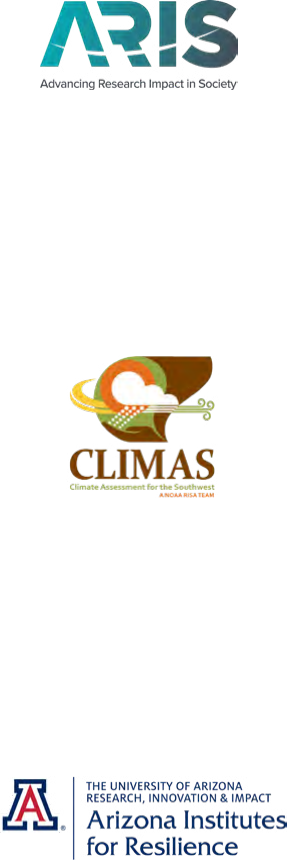
4
Suggested citation: Meadow, Alison M. and Gigi Owen (2021) Planning and
Evaluating the Societal Impacts of Climate Change Research Project: A guidebook for
natural and physical scientists looking to make a difference.
5
AUTHORS
Alison M. Meadow, Ph.D.
Associate Research Professor – University of Arizona; Arizona Institutes
for Resilience
Alison Meadow has a background in environmental anthropology and urban
planning. Her research focuses on the process of linking scientists with
decision makers to improve the usability of climate science, with a particular
emphasis on evaluating the outcomes of such research partnerships.
Gigi Owen, Ph.D.
Research Scientist, University of Arizona, Arizona Institutes for Resilience;
Climate Assessment for the Southwest (CLIMAS)
As a qualitative social scientist with a background in geography and political
ecology, Gigi’s research interests center on the interactions between humans
and their environments. Her current research portfolio includes building
equitable and resilient local food systems, assessing climate adaptation
strategies, and evaluating how interdisciplinary and transdisciplinary research
supports a thriving Southwest region.
ACKNOWLEDGEMENTS
We would like to thank The Center for Advancing Research Impacts in Society
(ARIS) for the opportunity to participate in the 2020 Fellows Program; our
colleagues in the 2020 ARIS fellows cohort; the Arizona Institutes for Resilience
at the University of Arizona; and Molly Hunter, Michelle Higgins, Connie
Woodhouse, Sarah Olsen, Natasha Wingerter, Julie Risien, and Peter Ruggiero
who reviewed and helped us refine, strengthen, and improve this guidebook.
This document was developed as part of the Advancing Research Impacts in
Society (ARIS) Center Fellows Program supported through a grant from the NSF
(#1810732). The findings and recommendations are those of the author(s) and do
not necessarily reflect the views of the National Science Foundation.
photography throughout courtesy of Unsplash

6

7
As scientists, we aim to generate new knowledge and insights about the
world around us. We often measure the impacts of our research by how many
times our colleagues reference our work – an indicator that our research has
contributed something new and important to our field of study. Considering
the challenges facing our society and environment, this type of impact is no
longer enough. Many researchers are seeking ways to have greater and more
direct impacts on communities and our environment by helping solve complex
challenges such as climate change.
But how can we structure our research to contribute directly to solving the
complex social and environmental challenges facing our communities and our
planet? This guidebook offers techniques to help researchers plan to increase
their impacts beyond academia as well as document and evaluate those impacts.
In order to identify and describe the impacts that may be generated by research,
we use a set of five impact types that range from creation of new connections
between researchers and partners in broader society to tangible, beneficial
changes in social and/or ecological systems (i.e. socio-ecological systems).
Collectively, we refer to this range of impacts as societal impacts.
The framework we present is applicable to all types of academic research.
However, we specifically tailored this guidebook for physical and natural
scientists working in the field of climate change. Global society is in a moment
where swift and intentional action is needed, but it seems difficult to know
which actions will be most effective and for whom. The environmental and
societal challenges associated with climate change are diverse and complex.
It is necessary to understand how climate research can most effectively guide
climate action, where it has been most successful doing so, and reveal the types
of action that are currently missing.
This guidebook is formatted into three main parts. In the first part we provide
background information about the societal impacts of research. In the second
part, we present a framework for planning for and assessing the societal
impacts of research, including worksheets and case studies. The third part
contains a series of appendices that provide additional context for the
information in this guidebook.
INTRODUCTION

8
Why consider the societal impacts of research?
1 See for example NSF Dear Colleague Letter 21-059, A Broader Impacts Framework for Proposals Submitted to NSF's Social, Behavioral, and Economic Sciences
Directorate.
The harmful social and environmental impacts associated
with global warming and climate change present urgent
and complex challenges for humankind. These challenges
have encouraged natural and physical scientists to
make their research more responsive to communities,
resource managers, and policy makers. Many researchers
choose the profession because they see possibilities for
generating new knowledge to benefit the environment and
society. However, academic researchers are not always
supported by their institutions or departments to engage
with societal partners, produce research outputs for public
audiences, or conduct applied research.
Funders and universities are starting to pay more
attention to the ways that academic research generates
positive impacts for society – in economic terms and
far beyond. In much of Europe, the United Kingdom, and
Australia, universities are required to report on their
societal impacts as part of the requirements to receive
federal research funding. In the U.S., the National Science
Foundation (NSF) includes broader impacts criteria in its
funding calls, which require applicants to describe their
plans to achieve impacts beyond the production of high-
quality research. For example, applicants may develop
activities that connect their fundamental research efforts
to empowering people and improving their quality of life.
1
Other federal funding programs also expect researchers to
engage with decision makers in the course of producing
“actionable” or “usable” knowledge. The Department of
the Interior’s Climate Adaptation Science Center network
is one example; the National Oceanic and Atmospheric
Administration’s long-running Regional Integrated Science
and Assessment program is another. Both programs
award 5-year grants to academic institutions that can
demonstrate skill and experience in producing science
about climate variability and change that can be directly
linked with resource management and policy making.
Crafting a societal impacts plan and an evidence-based
assessment of project impacts can improve your chances
of receiving funds from agencies that prioritize societal
and broader impacts.
PART 1.
Introducing Societal Impacts

9
Larger issues of trust and accountability are also in play
in considering societal impacts. Academic researchers can
help build relationships of trust between universities and
their surrounding communities through public engagement
and problem-solving at a local scale. The Association
of Public and Land Grant Universities’ recent report,
Public Impact Research: Engaged Universities Making
the Difference, makes the case that using public impact
research along with fundamental research, “communicates
powerfully to the public the value of university research
and could help restore public trust in our institutions.”
Researchers contribute to their university’s trust-building
work through effective engagement and by documenting
impacts in local, regional, or international communities.
2 Abel, Steve, and Rod Williams. 2019. The Guide: documenting, evaluating and recognizing engaged scholarship.: Purdue University, Office of Engagement.
3 See for example:
Alvesson, Mats, Yiannis Gabriel, and Roland Paulsen. 2017. Return to meaning: A social science with something to say: Oxford University Press.
Foster, Kevin Michael. 2010. Taking a stand: Community-engaged scholarship on the tenure track. Journal of Community Engagement and Scholarship 3 (2):20.
Hicks, Diana, Paul Wouters, Ludo Waltman, Sarah De Rijcke, and Ismael Rafols. 2015. Bibliometrics: the Leiden Manifesto for research metrics. Nature News 520
(7548):429.
4 See Appendix D for more information regarding concerns about the role of societal impacts in academic performance reviews.
At the scale of individual researchers, societal impacts
have not often been included in academic assessments for
promotion and tenure. This trend, however, is changing.
For example, Purdue University now includes promotion
and tenure criteria that is specific to engaged scholarship.
2
Other efforts have been made to broaden academic
performance metrics beyond the restrictive focus on
publications, citations, and grants and include measures of
societal relevance and impact.
3
A well-crafted and well-
supported statement on the societal impacts of research
can be integrated into performance review and promotion
packets as an example of outreach and service.
4

10
What are Societal Impacts?
Societal impacts are the ways that research, and the process of conducting research, influences the world
beyond the academic realm.
While often in the climate and environmental sciences, we aspire to long-term and large-scale impacts like
measurable risk reduction or changes in ecosystem health, these kinds of impacts take substantial time to
develop and are dependent on a wide range of variables, such as the ability of societal partners to enact
new policies or practices. For example, a forest may not be demonstrably more resilient to fire in the span
of 2-3 years—the length of a typical research grant. Likewise, a city may not know if it is more resilient to
storm surges until the next time a large storm hits. However, there are a range of nearer-term impacts that
occur along a pathway to long-term and large-scale impact that can tell us about the ways in which our
research is helping to make beneficial changes.
In this guidebook, we present five categories of societal impacts. However, we focus on four that are more
likely to manifest on short- to medium-term timescales. We can observe and document these impacts and
use them as indicators of the likelihood of future socio-environmental impacts. Throughout this guidebook,
you will see most of our discussion involves the first four categories, but we will occasionally reference the
fifth (socio-environmental impacts) as part of the larger context of impacts evaluation.
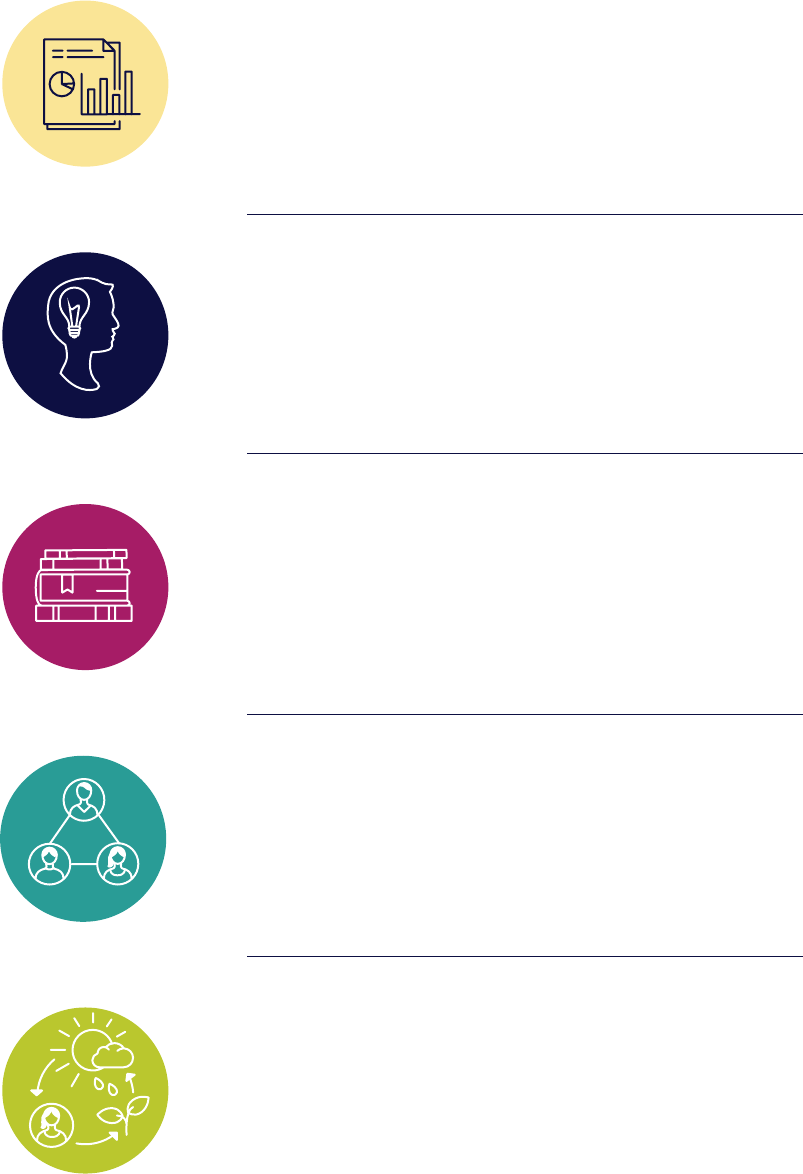
11
FIVE CATEGORIES OF SOCIETAL IMPACTS
Instrumental applications
your research led to tangible changes to plans, decisions,
practices, or policies
Conceptual impacts
your research contributed to changes in people’s knowledge
about or awareness of an issue
Capacity building impacts
your research contributed to enhancing the skills, expertise, or
resources of an organization or group of people
Connectivity impacts
your research led to new or strengthened relationships,
partnerships, or networks that endure after the project ends
Socio-environmental impacts
changes to social and/or ecological systems, such as
improvements in health and well-being or in ecosystem
structure and function, that result from actions taken because
of your research.
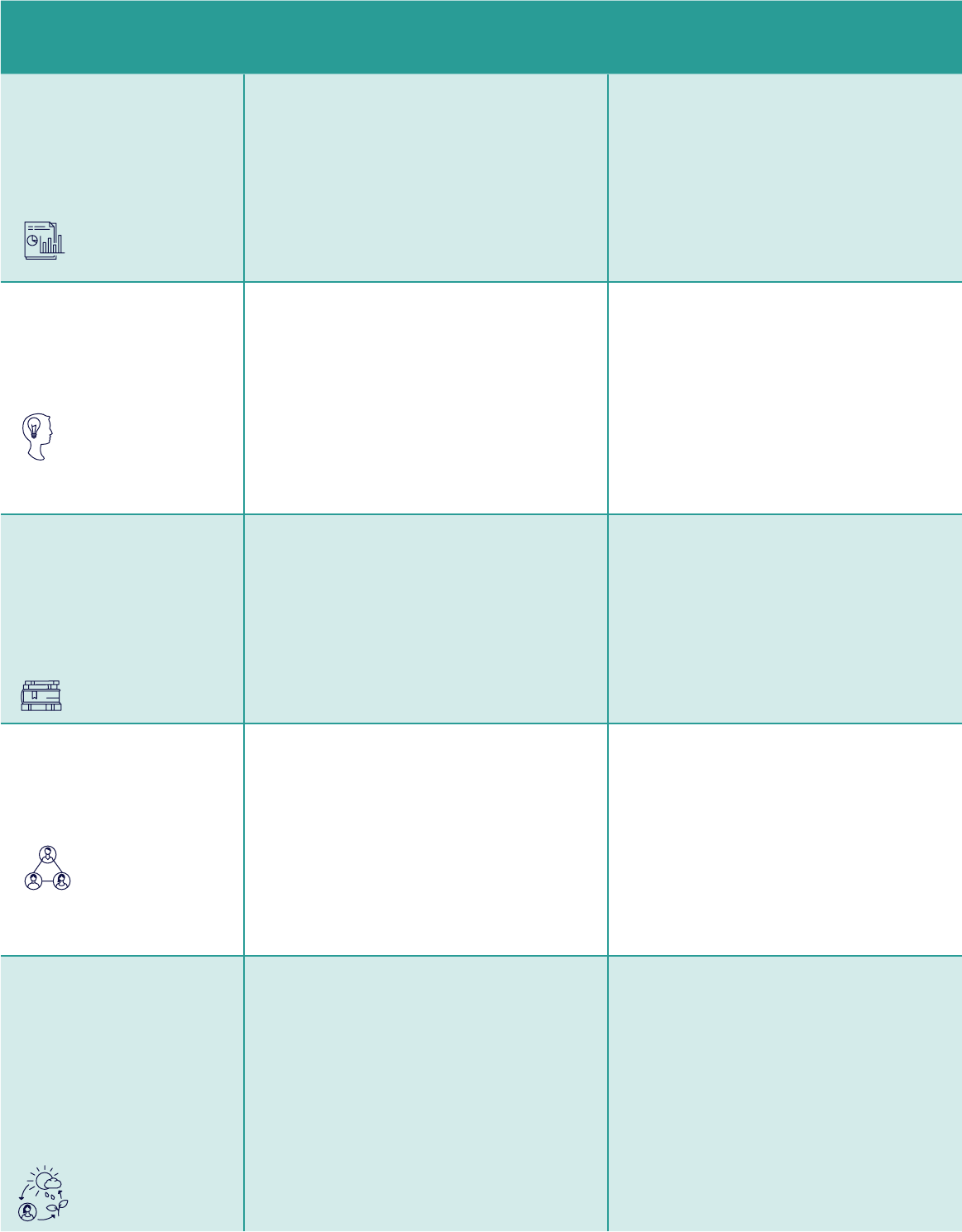
Societal impact
categories
Example in practice #1 Example in practice #2
Instrumental
impacts
Changes to plans, decisions,
practices, or policies
“We worked with the staff of the local wildlife
management agency throughout this research.
When it came time for them to update their
species management plan, they cited our report
and journal article in the plan. They also asked
both myself (PI) and my Co-I to review their
plan to ensure that the research findings were
explained accurately.”
“The state Department of Transportation used
our research findings regarding drought and
the sources and patterns of dust storms,
which have caused numerous highway
casualties, to apply for federal funds to improve
highway signs, warnings, and road markings.
Funding was approved; new infrastructure was
installed in 2017.”
Conceptual impacts
Changes in people’s knowledge
about or awareness of an issue
“Health professionals who participated in this
project reported that they understood the
science behind regional temperature projections
much better than when the project started.
Two of these professionals took the initiative
to present the findings of our research to an
internal group in their health center, in order to
explain the research methods and findings to
their colleagues.”
“Results from our paleoclimate project,
conducted with a federal agency, provided
new insight into how temperatures impact
streamflow and drought in the Colorado River
basin. During subsequent meetings, water
managers explicitly discussed how they could
apply this insight into new techniques for
water management.”
Capacity building
impacts
Enhancing the skills, expertise,
or resources of an organization
or group of people
“Three graduate students, from backgrounds
often under-represented in STEM fields,
participated in this project. They gained data
collection, analysis, and project management
skills, participated in the writing of four
academic papers, and all three were accepted
into post-doctoral climate research programs.”
“We provided municipal planners with data
about flooding impacts on their city. We worked
with them in several workshops and phone
calls to ensure the data were clearly presented
and addressed the planning needs of the
city. Our partners have said they already feel
more confident and capable when discussing
flooding with city residents.”
Connectivity impacts
New or strengthened
relationships
“A group of city planners met for the first time
at a workshop we held as part of our project.
After the workshop, this group began meeting
regularly to collaborate on a funding proposal
for their city. They continue to invite me [the
researcher] to attend their meetings, and I do on
a regular basis.”
“In 2015, utility employees identified several
climate and environmental risks that could
impact their operations. Our research
team provided them with tailored data and
analyses to address their concerns. A year
later, utility employees contacted us again to
propose collaborating to develop scenarios for
carbon reduction. has turned into an ongoing
new project.”
Socio-environmental
impacts
Changes to social or ecological
systems, such as improved
health and well-being
or ecosystem structure
and function
“Our research team modeled the likelihood of
future heatwaves in our region. After working
with us on the research project, the City revised
its extreme heat response protocols. We now
have 10 years of data on heat-related deaths
in the city which show a significant decline,
despite the fact that we’ve had more and hotter
heatwaves during this same 10-year period.”
“We worked with local residents to develop a
reforestation plan, using findings from previous
research. The residents got funding from the
City for the project and they planted over 200
trees. Over the last three years, residents
noticed that several bird and mammal species
had repopulated the area. The reforestation
plan is bringing back biodiversity to the region.”

13
Societal impact
categories
Example in practice #1 Example in practice #2
Instrumental
impacts
Changes to plans, decisions,
practices, or policies
“We worked with the staff of the local wildlife
management agency throughout this research.
When it came time for them to update their
species management plan, they cited our report
and journal article in the plan. They also asked
both myself (PI) and my Co-I to review their
plan to ensure that the research findings were
explained accurately.”
“The state Department of Transportation used
our research findings regarding drought and
the sources and patterns of dust storms,
which have caused numerous highway
casualties, to apply for federal funds to improve
highway signs, warnings, and road markings.
Funding was approved; new infrastructure was
installed in 2017.”
Conceptual impacts
Changes in people’s knowledge
about or awareness of an issue
“Health professionals who participated in this
project reported that they understood the
science behind regional temperature projections
much better than when the project started.
Two of these professionals took the initiative
to present the findings of our research to an
internal group in their health center, in order to
explain the research methods and findings to
their colleagues.”
“Results from our paleoclimate project,
conducted with a federal agency, provided
new insight into how temperatures impact
streamflow and drought in the Colorado River
basin. During subsequent meetings, water
managers explicitly discussed how they could
apply this insight into new techniques for
water management.”
Capacity building
impacts
Enhancing the skills, expertise,
or resources of an organization
or group of people
“Three graduate students, from backgrounds
often under-represented in STEM fields,
participated in this project. They gained data
collection, analysis, and project management
skills, participated in the writing of four
academic papers, and all three were accepted
into post-doctoral climate research programs.”
“We provided municipal planners with data
about flooding impacts on their city. We worked
with them in several workshops and phone
calls to ensure the data were clearly presented
and addressed the planning needs of the
city. Our partners have said they already feel
more confident and capable when discussing
flooding with city residents.”
Connectivity impacts
New or strengthened
relationships
“A group of city planners met for the first time
at a workshop we held as part of our project.
After the workshop, this group began meeting
regularly to collaborate on a funding proposal
for their city. They continue to invite me [the
researcher] to attend their meetings, and I do on
a regular basis.”
“In 2015, utility employees identified several
climate and environmental risks that could
impact their operations. Our research
team provided them with tailored data and
analyses to address their concerns. A year
later, utility employees contacted us again to
propose collaborating to develop scenarios for
carbon reduction. has turned into an ongoing
new project.”
Socio-environmental
impacts
Changes to social or ecological
systems, such as improved
health and well-being
or ecosystem structure
and function
“Our research team modeled the likelihood of
future heatwaves in our region. After working
with us on the research project, the City revised
its extreme heat response protocols. We now
have 10 years of data on heat-related deaths
in the city which show a significant decline,
despite the fact that we’ve had more and hotter
heatwaves during this same 10-year period.”
“We worked with local residents to develop a
reforestation plan, using findings from previous
research. The residents got funding from the
City for the project and they planted over 200
trees. Over the last three years, residents
noticed that several bird and mammal species
had repopulated the area. The reforestation
plan is bringing back biodiversity to the region.”
These categories do not represent all possible
types of societal impacts.
5
However, they provide
a foundation for exploring the societal impacts
of climate-related research. If your research
generates impacts that do not fit in one of these
five categories, you can still use the framework
presented in this guidebook to identify and
document your research impact and insert your
own impact categories as appropriate.
6
Impact categories are not hierarchical – one is not
more important than another. They all represent
meaningful results from the process of conducting
research. Impacts may interact within and across
categories and will often amplify each other.
For example, a network established to connect
researchers and policymakers may improve
relationships and trust among network members.
Within the network, policymakers feel free to ask
key questions, consider new data, and ultimately
become sufficiently confident in the research to
include it in a new environmental policy. All the
impact categories can contribute to beneficial
socio-environmental changes. They are worth
tracking to understand the changes that have
already occurred; they also indicate the likelihood
that more changes are coming.
5 Other frameworks can be found in:
Pedersen, David Budtz, Jonas Følsgaard Grønvad, and Rolf
Hvidtfeldt. 2020. Methods for mapping the impact of social sciences
and humanities—A literature review. Research Evaluation 29 (1):4-21.
Reed, Mark S. 2018. The Research Impact Handbook. 2nd ed: Fast
Track Impact.
Edwards, David M, and Laura R Meagher. 2020. A framework to
evaluate the impacts of research on policy and practice: A forestry
pilot study. Forest Policy and Economics. 114: 101975.
6 See Appendix A for further discussion about categories of
societal impacts.
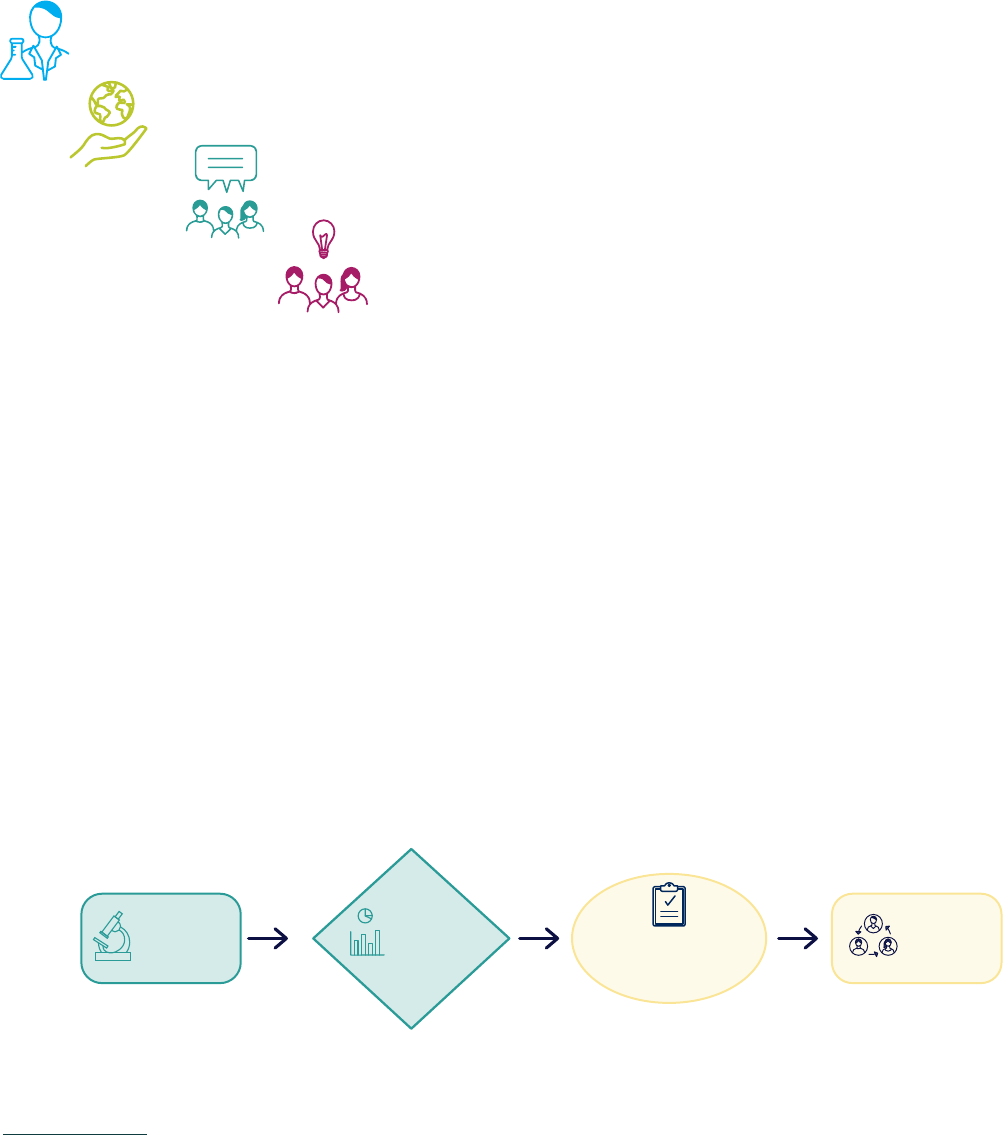
14
How do researchers generate societal impacts?
There are several pathways that connect research to societal impacts. Often, they
flow through the following steps:
#1. You do robust, credible, and relevant research.
#2. That research connects to society.
#3. Societal partners use that research.
#4. That research changes something in the world.
It is in Step #2 — how research connects to society – that a number of different
pathways toward generating societal impacts open up. We introduce a few of these
pathways below.
Indirect Connections between Research and Research Users
One pathway involves indirect connections between researchers and research users. Perhaps someone comes across
your research findings in a book, journal article, or report and uses it to address their needs. They might cite these
research findings in a management or policy document. Along the indirect pathway, the researcher and the person
using research findings never interact in person. Indirect pathways are sometimes referred to as a “classical pipeline” or
“loading dock” model.
7
7 Read more about the “classical pipeline” pathway in: Muhonen, Reetta, Paul Benneworth, and Julia Olmos-Peñuela. 2020. From productive interactions to impact
pathways: Understanding the key dimensions in developing SSH research societal impact. Research Evaluation 29 (1):34-47.
Read more about the “loading-dock” model in: Cash, D. W., J. C. Borck, and A. G. Patt. 2006. Countering the loading-dock approach to linking science and decision
making - Comparative analysis of El Nino/Southern Oscillation (ENSO) forecasting systems. Science, Technology and Human Values 31 (4):465-494.
RESEARCH
RESEARCH
OUTPUT
POLICY MAKER OR
PRACTITIONER
SOCIETAL
IMPACT
Adapted from Muhonen et al. 2020
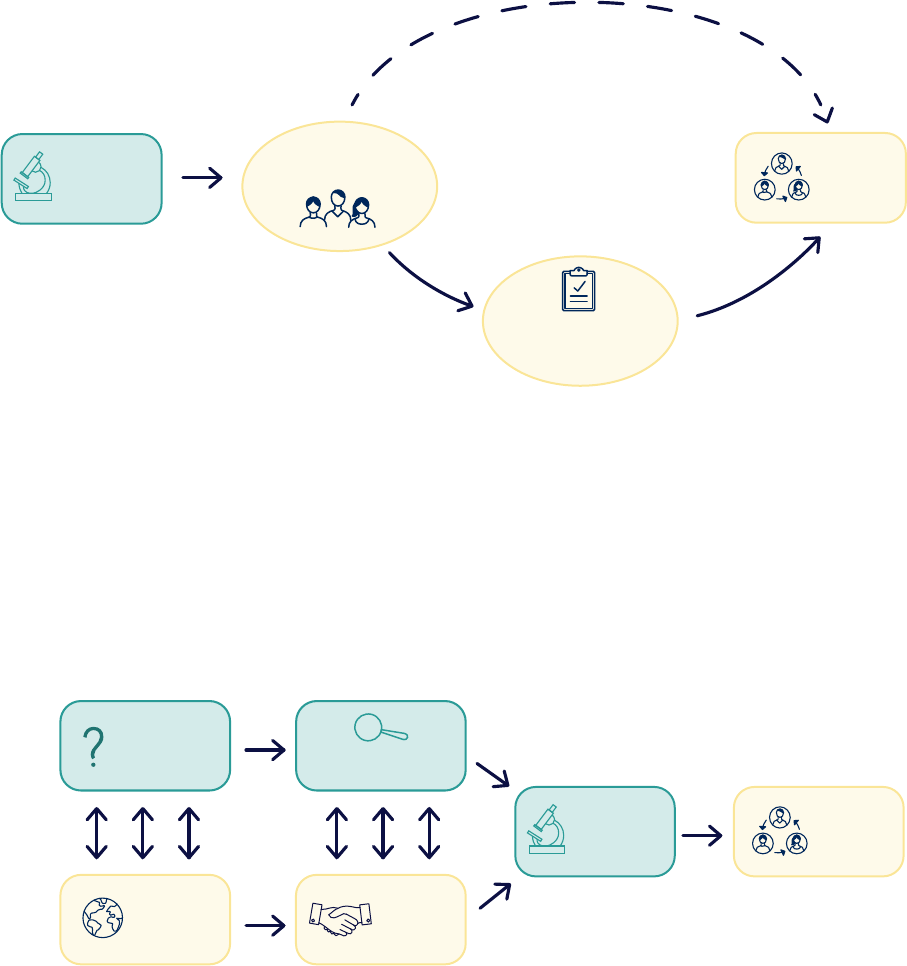
15
Connecting through Public Engagement
A second pathway involves public engagement activities like giving talks to the general public or having your research
appear in news media, social media, or popular media like podcasts. In this case, members of the public may choose to
use your findings in their lives and the information might be conveyed from the general public into a policy or practice
use, such as if citizens advocate for a particular governmental action.
Direct Engagement Between Researchers and Societal Partners
A third pathway involves direct engagement between researchers and societal partners over the course of a project.
These partners might include natural resource managers, policy makers, or those responsible for managing the impacts
of climate change within their community, city, region, or country.
PUBLIC
AUDIENCE
SOCIETAL
IMPACT
RESEARCH
POLICY MAKER OR
PRACTITIONER
Adapted from Muhonen et al. 2020
SOCIETAL
IMPACT
RESEARCH
SOCIETAL
PARTNERS
RESEARCHERS
RESEARCH
QUESTION
SOCIETAL
NEED
Adapted from Muhonen et al. 2020
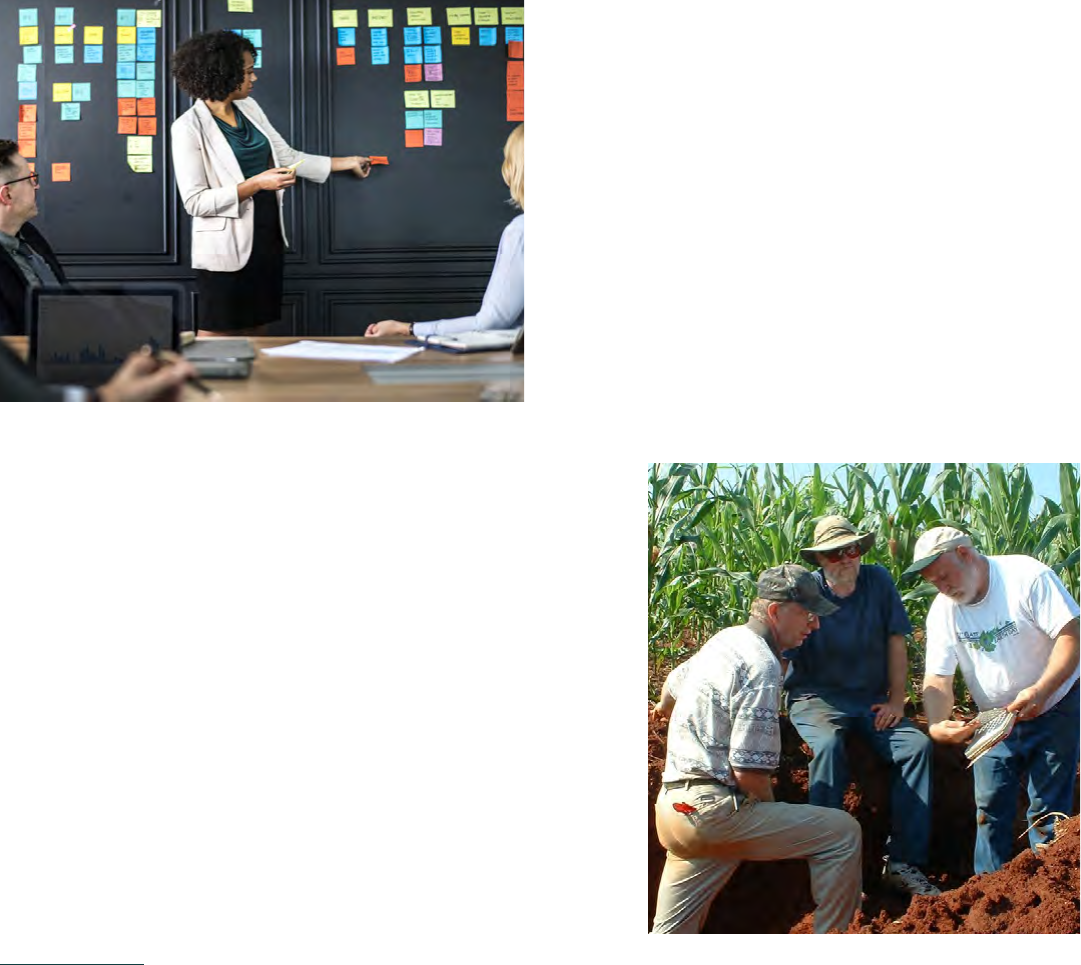
16
This guidebook focuses mostly on this third pathway – direct interaction between researchers and societal partners
throughout the research process. This pathway stems from decades of evolution in socially-engaged research practices,
which are more consistently effective in generating research that is useful to and used by society.
8
This approach
might involve interactive activities such as: researchers and societal partners jointly developing research questions and
project design, conducting fieldwork together, collectively analyzing data, and producing co-authored outputs, such as
papers or reports.
Who are societal partners?
In this guidebook, we use the term “societal partners,” or
“partners” for short, to refer to people who are engaged
in a research project but live or work outside of the
formal, academic research enterprise. Other common
terms for this group of people include practitioners,
decision makers, stakeholders, and community partners.
Our use of the term societal partners indicates that the
people engaged in the research process, and those who
are affected by the research, are active participants
in the research effort—not passive recipients of the
research outcomes.
Although engaged research approaches are the most effective
in moving research into use, these approaches come with some
challenges. They tend to be more time and resource intensive, which
imposes some “costs” on participants in terms of their own time,
energy, and resources. This is true for both researchers – who also
need to devote time and energy to their academic impacts – and
for societal partners – who also need to devote time and energy to
their own work and life responsibilities. Often, societal partners are
asked to participate in multiple research efforts due to their unique
perspectives or experiences. It is important to be aware of partner
burn-out
9
and researcher stress.
10
Some of these additional “costs”
can be mitigated through careful project planning and ensuring
adequate research funding and time.
8 See Appendix B for more information on socially-engaged research practices.
9 Young, Nathan, Steven J Cooke, Scott G Hinch, Celeste DiGiovanni, Marianne Corriveau, Samuel Fortin, Vivian M Nguyen, and Ann-Magnhild Solås. 2020. “Consulted
to death”: Personal stress as a major barrier to environmental co-management. Journal of environmental management 254:109820.
10 Cvitanovic, Christopher, Mark Howden, RM Colvin, Albert Norström, Alison M Meadow, and PFE Addison. 2019. Maximising the benefits of participatory climate
adaptation research by understanding and managing the associated challenges and risks. Environmental Science & Policy 94:20-31.

17
Contribution or Attribution?
Although it can be tempting to try to connect a research effort to a new policy or to an environmental change,
generating societal impacts from research is rarely a straight line. It is not always (quite rarely, really) possible to
attribute a change in policy, practice, or in the socio-ecological system directly to one particular research finding or
project. Multiple factors influence whether research is used and what impact it has for the intended users. Perhaps your
partners realize they need to build more internal capacity before being able to move forward with a new plan. Or, as is
often the case, the organization’s decision-making framework may require evidence from multiple sources before feeling
confident in taking action. Sometimes, a perfectly planned and executed project does not result in anticipated changes
due to factors outside of your control, such as budgetary constraints or changes in leadership.
Although it is not always possible to attribute specific impacts to individual projects, it does not mean that a project
has not been successful. More often, research has been a contributing factor – or one of several factors – in creating
change. While a singular research project or finding is not typically the sole factor in generating an impact, we can still
illustrate how and in what ways it contributed to the impact. Contributing to change is a positive outcome and should be
reported as such.
In a contribution model, like the one below, you might see that your research was one part of the process of making
changes in practice that ultimately contributed to improved environmental conditions.
Practitioners
work to make
changes in their
organizations
Sufficient
amount of
evidence
accumulated
Necessary new
skills acquired
Other
research
efforts
Other
research
efforts
Your
research
Improved
societal and
environmental
conditions
New
Management
practice in use
Professional
development
opportunity
How Research Contributes to Societal Impacts

18
First, your research might be one of several projects examining the phenomenon in question. A management agency is
likely to require several sources of evidence before it is willing to consider a change in practice. Therefore, having your
research as part of that evidence is crucial to the process. Second, a change in practice may require agency staff to
develop new skills. The agency may seek that training from another source and that source becomes another contributor
to the impact. When the new evidence and training is combined, the agency may be more able and willing to make the
change in practice. However, work still must take place within the agency to craft new policy language, move it through
internal decision channels, and secure appropriate funding – all of which require significant effort and know-how on the
part of agency personnel. In this example, that change in practice eventually leads to improved environmental outcomes.
The conceptual model below illustrates how one research project is part of a larger system that supports a change in
practice and, ultimately, a change in environmental conditions. While your research project may not be solely responsible
for changes in practice, policy, or socio-environmental conditions, using a contribution model like this one helps
demonstrate how your work has contributed to those greater impacts.
11
11 See Appendix C for more information about the challenges of documenting societal impacts.
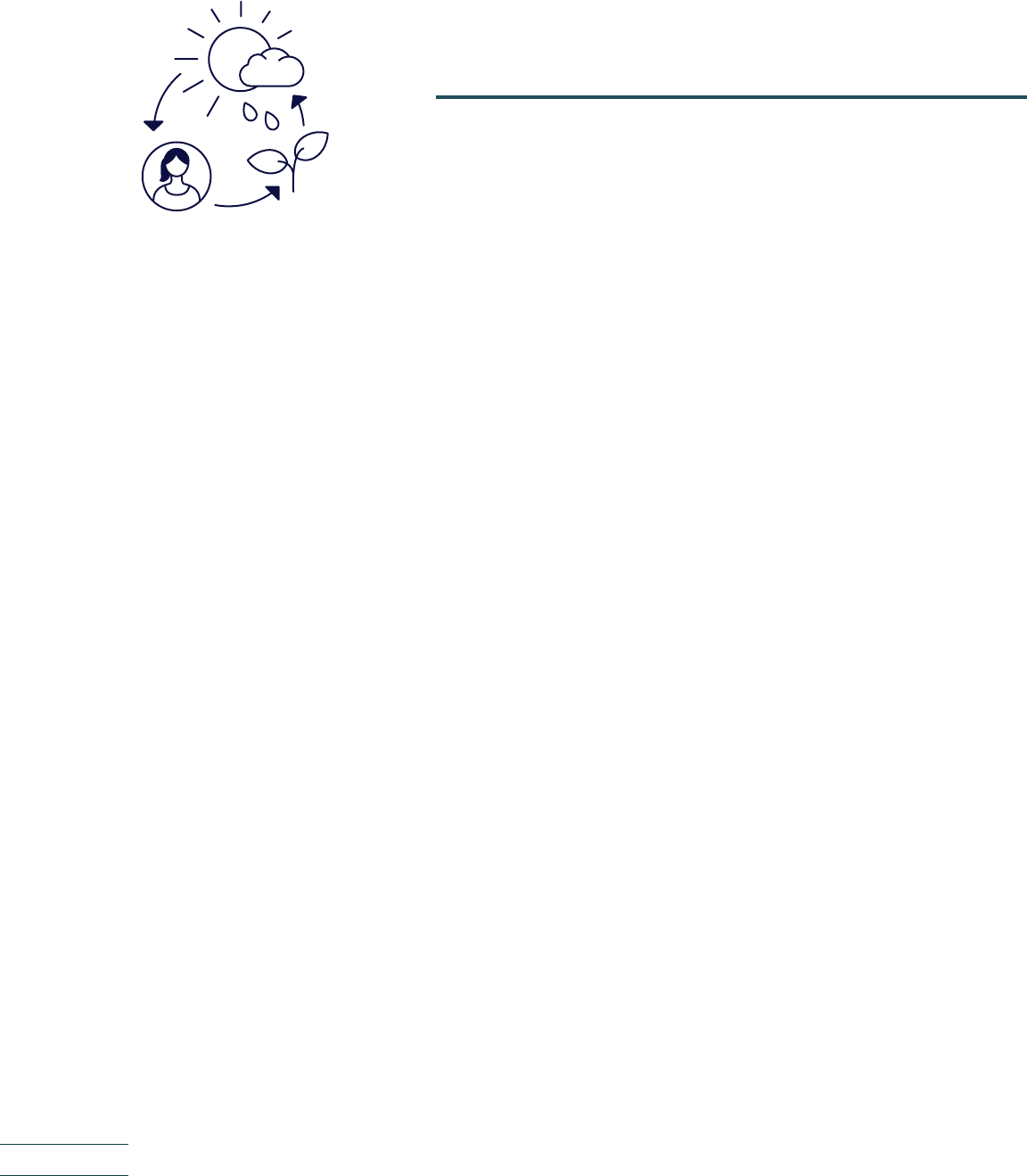
19
The process for identifying and documenting research
impacts presented in this guidebook is built on an
outcome-oriented logic model framework.
12
Logic models
have similar basic components, but do not always look
the same. They can be adjusted to apply to projects and
programs in multiple ways. Logic models are not rigid;
they are flexible tools that can be used in a variety of
ways. A general way to understand logic models is that
they offer a comprehensive explanation of how and why
a desired change is expected to happen in a particular
context. This framework invites researchers to make
explicit connections between project resources, activities,
outputs, and how these lead to specific
impacts or changes.
12 See W.K. Kellogg Foundation http://www.wkkf.org/knowledgecenter/resources/2006/02/WK-Kellogg-Foundation-Logic-Model-Development-Guide.aspx
In this section, we present two applications of the logic
model framework. The first variation is meant to guide
researchers who are in the planning and design stages
of a project. The second variation is geared toward
researchers who are in the middle or final stages of a
project and want to document impacts that have already
occurred. To illustrate how this framework functions, we
will work through both variations separately and apply
them to a case study example about coastal flooding and
sea level rise.
PART 2.
Societal Impacts Planning
and Assessment Frameworks
2.1 Framework for Project Planning and Design
Generating societal impacts requires re-thinking the way research projects are designed. For example, the degree
to which societal partners are involved (or not) at various steps of the research process will determine the types of
impact.
13
Used during research planning, design, and proposal writing stages, the following logic model framework
encourages researchers to think through and explicitly connect what they anticipate doing and producing during their
project, to the societal impacts they anticipate achieving at the end of their project.
13 Shirk, Jennifer L, Heidi L Ballard, Candie C Wilderman, Tina Phillips, Andrea Wiggins, Rebecca Jordan, Ellen McCallie, Matthew Minarchek, Bruce V Lewenstein, and
Marianne E Krasny. 2012. Public participation in scientific research: a framework for deliberate design. Ecology and society 17 (2).
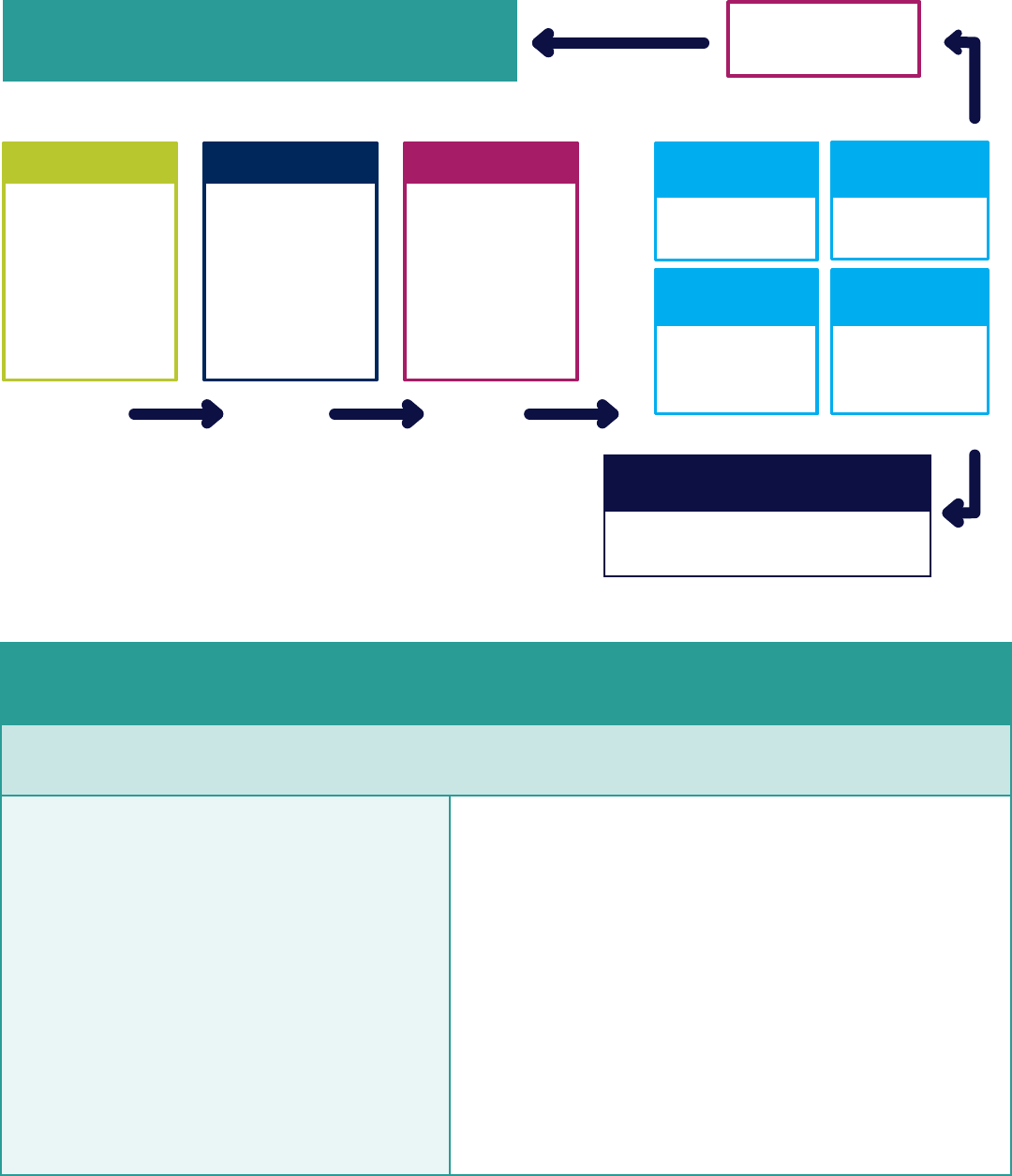
20
ACTIONS/ACTIVITIES
OUTPUTS
How will you
address the issue?
• Methods for
engagement
with partners
• Project activities
INPUTS
What are the
interests of both the
researchers and
societal partners?
What resources
and expertise are
necessary for
this project?
What tangible
products do you
expect to produce?
• Reports
• Papers
• Circula
•Databases
SOCIO-ENVIRONMENTAL IMPACTS
Changes to social or ecological
systems over time
For whom,
will things change
CONCEPTUAL
IMPACTS
INSTRUMENTAL
IMPACTS
CONNECTIVITY
IMPACTS
CAPACITY BUILDING
IMPACTS
Gain new knowledge
or awareness
Direct applications
of research
Establish or
strengthen
partnerships
Gain or improve
skills or expertise
What societal problem do you aim
to address in your research?
PROBLEM STATEMENT
What societal problem do you aim to address in your research?
Write out the specific societal or
environmental issue that your research
addresses. It should speak to the broader
issue that your research will inform. Most
likely, it will be different from your actual
research questions or objectives. In your
statement, include who is affected by this
issue.
Floodsville Project Problem Statement:
A tropical storm caused major flooding in a neighborhood of
the City of Floodsville. Ocean water breached the existing
coastal wall, leading the city’s planners and emergency
managers to question whether they had the most accurate
projections for sea level rise. They need to up-to-date sea
level rise information so they can make better informed
policies and decisions for the future of the city.

21
INPUTS
• What resources are available or necessary to conduct your research?
• What are the interests of both the researchers and the research partners?
Describe the inputs that you have available or
that you will need to conduct your research.
Your inputs will vary depending on the type
of project you are conducting. Fundamental
resources include time and funding. Consider
the human resources needed to carry out your
research, including skills, types of knowledge,
and expertise. Describe the members of your
research team (including yourself) and the
expertise, knowledge, and skills each person
offers to the project. If you do not already have a
research team established, write down the types
of members you will seek out. Once your team is
established, each member should think through
their individual motivations for participating
in the research. What kinds of societal impact
goals motivate each research team member?
How will they contribute toward those impacts?
The financial and human resources available
and the motivations of the research team will
drive the research design, as well as the project’s
activities, outputs, and impacts.
Floodsville Project Inputs:
Human resources needed:
• Climatologist with skill in climate modeling, experience
with sea level rise
• GIS specialist to map model projections
• Floodsville City official with knowledge about
city policies and the climate adaptation plan and
connections to city planners and emergency managers
• Neighborhood Association representative where
flooding occurred
• Social scientist to gather qualitative data about
residents’ experiences
Physical resources needed:
• Funding for climate modeler, GIS specialist, social
scientist, neighborhood association representative
• Time from city officials who participate in the project
• Time from community members who participate
in the project
Motivations, objectives, and interests of the
research team:
• Climatologist: to apply their modeling knowledge to a
specific societal issue
• GIS specialist: to fulfill their contract, but wants to help
solve the City’s issue
• City official: to ensure safety for the future of the City
• Community member: to ensure safety for
neighborhood residents
• Social scientist: to engage with local community
members and help inform a better adaptation plan

22
ACTIVITIES
• What activities will you do to address the broader societal issue?
• Do your proposed project activities incorporate the project inputs and the interests of your
research team?
In the activities section, focus on the
infrastructure of your project, which may
include things such as: a calendar timeline
of your proposed activities; the research
methods you will use; a description about
how you and your research team plan to
interact and communicate throughout the
project; or describing the responsibilities of
each member of the research team.
Floodsville Project Activities:
This two-year project will include two main
components of research:
1. Risk assessment: analyzing current climate models
for sea level rise for the region around Floodsville. The
climatologist will run the model analyses and produce
downscaled climate projections. She will coordinate with
the GIS specialist to construct risk maps for the region
based on these analyses.
2. Qualitative analysis of people’s experiences with the
flood and future plans to deal with flood risk. The
social scientist will coordinate with the community
representative and the Floodsville city official to develop
protocol for focus groups with the neighborhood
association and with city planners and emergency
managers. Three focus groups will occur with the
neighborhood association and three will occur with the
city planners and emergency managers in the first year.
The entire research team will meet monthly throughout the
project to discuss updates and coordinate next steps. Between
regular meetings, team members will communicate via email
and phone as necessary.
At the end of the project, the research team will present
findings and recommendations for the city’s adaptation plan to
city officials, planners, and emergency managers. We will also
present our findings at a neighborhood association meeting.

23
OUTPUTS
• What do you plan to produce through your research?
In this section, write out the tangible research
outputs that you and your team plan to produce
over the course of your project. These outputs
may include several different types of products,
such as: data analyses and models; public
outreach materials; white papers and peer-
reviewed articles; teaching curricula or training
materials; reports tailored to specific audiences;
websites; or fact sheets. As you outline this
section, think about when you want these
outputs to be completed, keeping in mind that
some of them may fall outside of your anticipated
timeline.
Floodsville Project Outputs:
1. Climate model analysis
(Completed in 6 months)
2. Risk map of Floodsville region
(Completed by end of Year 1)
3. Policy recommendations for City’s Adaptation Plan
regarding sea level rise
(Completed in 18 months)
4. Fact sheet report for neighborhood where flooding
occurred (printed and available on City website;
completed by end of Year 2)
5. Peer-reviewed paper submitted
(completed 1 year after end of project)

24
IMPACTS
• What do you expect to change as a result of your activities, your interactions with the public and your
research partners, and your outputs?
• For whom will things change or who will change because of your research?
In this section, think through the types of
impacts you anticipate having through your
research project. Your impacts section does
not need to be comprehensive, but it should
contain a list of attainable goals. As we know,
research projects often do not proceed as
intended. Not all research projects will yield
outcomes in all categories. Achieving one
impact may depend on accomplishments
in other impact categories. At the end of
a project, you may also discover several
unanticipated impacts.
We suggest starting with the first four of the
five categories of impact we introduced earlier
in this guidebook, which include:
• Conceptual impacts – new knowledge or
awareness gained
• Connectivity impacts – partnerships
established or strengthened
• Capacity building impacts – skills or
expertise strengthened or acquired
• Instrumental impacts – direct
applications of research
As you work through your anticipated impacts,
define who your societal partners are, such as:
resource management agency representatives,
policy makers or government officials,
community members, industry professionals,
students, or members of the general public. As
part of this section, you might also consider
the demographics of the people who will be
impacted by your research. Will your research
impact the audiences that you aim to reach?
Floodsville Project Impacts:
Conceptual impacts
• City officials, planners and emergency managers have a
better understanding of future flood risk and sea level rise;
they also understand the experiences of the residents
whose neighborhood was flooded
• Neighborhood residents have increased awareness about
why the recent flooding happened and the future impacts
they might face
• Researchers have a better understanding of the city
planning processes and experiences of flooding in the city
Capacity building impacts
• City residents feel better equipped to prepare for
future flood risk
• City officials feel equipped to discuss climate projections
and make decisions to address future flood risk
Connectivity impacts
• Connect city officials with neighborhood residents
• Increase connections between emergency planners and
city managers – currently there is little communication
between these agencies.
Instrumental impacts
• Inform Floodsville’s new multi-hazard mitigation plan
regarding flood
• Inform emergency management policies to deal with
future flood risk
Socio-ecological impacts (long-term aspirations)
• As sea-level rise occurs, Floodsville does not experience
any further flooding
• Floodsville saves significant amounts of money by
implementing actions from their hazard mitigation plan

25
PLANS TO COLLECT EVIDENCE OF CHANGE
• How will you know that your research changed things for people?
Your research design should incorporate plans
to systematically collect pieces of evidence that
corroborate the impacts of your research. Some
research projects will require external evaluation,
which can generate high quality data from formal
surveys, interviews, and even randomized control
trials. However, societal impacts evidence can
also be collected by research team members
and societal partners. These sources of evidence
might include: feedback from partners in the
form of emails, letters, or conversations you are
able to document; reference to your work in a
management/policy document; or feedback from
the general public.
Floodsville Project Evidence of Change:
• Citations in Floodsville’s Multi-Hazard Mitigation Plan
• Emails and discussions with City officials, planners, and
emergency managers and with neighborhood residents
• Solicit feedback via survey at final project meetings
with City officials, planners, and emergency managers
and with neighborhood residents
REVIEW YOUR PLAN
Once you have completed outlining each piece
of your project framework, review your plan to
see if each step logically flows into the next
step. Make sure your inputs relate to your project
activities; that activities relate to outputs; that
your outputs relate to your anticipated impacts;
and that impacts address the original interests
and motivations of the research team. Write a
quick summary about how your impacts address
the societal problem you are trying to inform with
your research.
Floodsville Project Design Review:
This project will provide up-to-date projections for sea
level rise in the region around the City of Floodsville.
By working with city officials, planners, and emergency
managers, as well as gathering evidence with
neighborhood residents, our project will provide insight
into how people cope with flood-related disasters
and will help them prepare for, and hopefully prevent,
future flood risk.
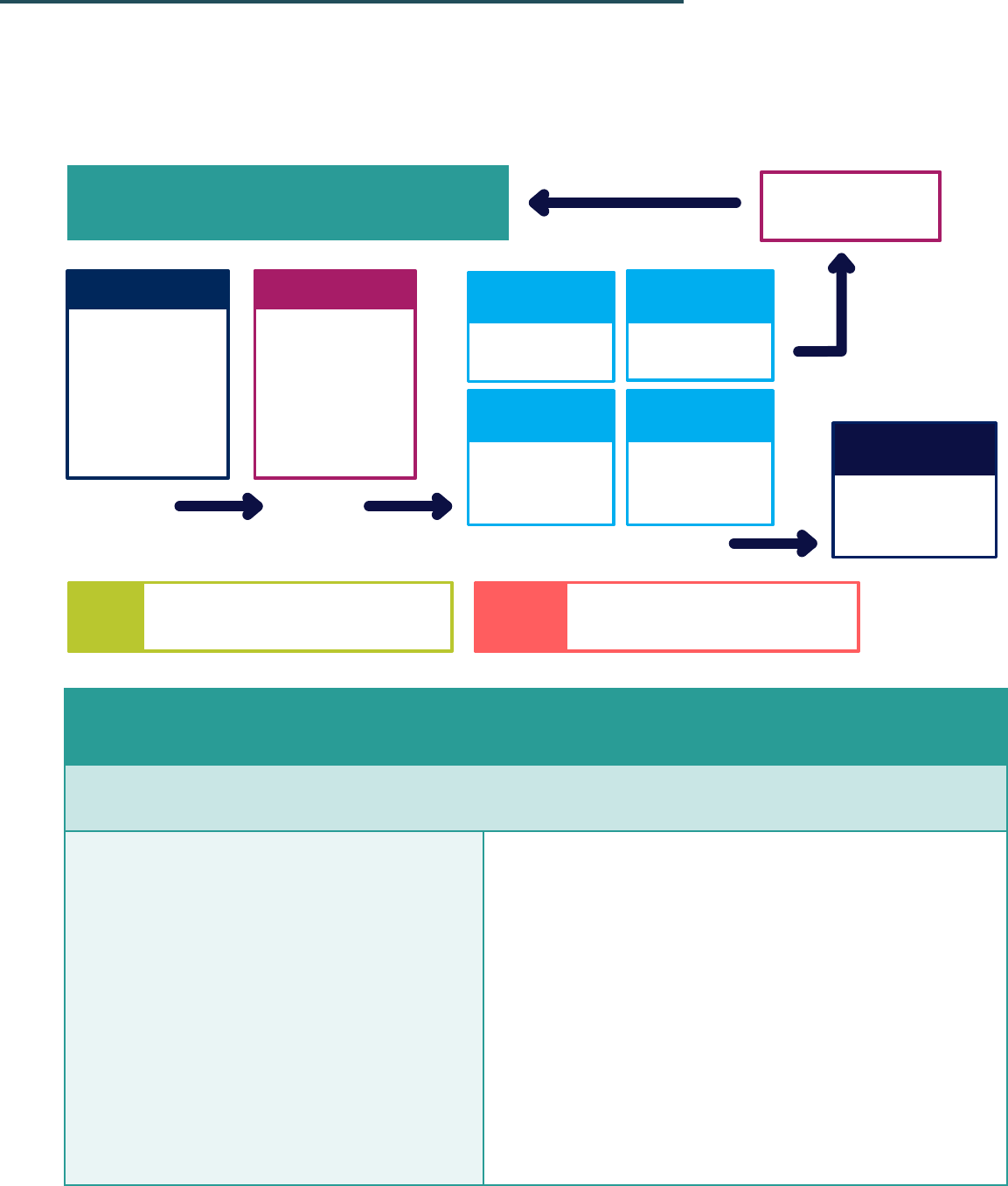
26
2.2
Societal Impacts Framework for Impact
Assessment and Project Reflection
What societal problem did you aim
to address in your research?
ACTIONS/ACTIVITIES
OUTPUTS
INPUTS CONTEXT
CONCEPTUAL
IMPACTS
INSTRUMENTAL
IMPACTS
CONNECTIVITY
IMPACTS
CAPACITY BUILDING
IMPACTS
SOCIO-ENVIRONMENTAL
IMPACTS
How did you try to
address it?
• Methods for
engagement
with partners
• Project activities
What resources, skills,
and existing relationships enabled
you to conduct your research?
What social, environmental, and
political factors facilitated or
inhibitied your research?
What tangible
products did
you produce?
• Reports
• Papers
• Circula
•Databases
New knowledge or
awareness gained
Direct applications
of research
Partnerships
established or
strengthened
Skills, expertise
strengthened or
acquired
Changes to social or
ecological systems
over time
For whom,
did things change
PROBLEM STATEMENT
• What societal problem did you aim to address in your research?
Summarize the specific societal or
environmental issue that you addressed in
your research in one or two sentences. It will
likely be different from your actual research
questions or objectives. In your statement,
include who was affected by this issue.
Floodsville Project Problem Statement:
A tropical storm caused major flooding in a neighborhood of
the City of Floodsville. Ocean water breached the existing
coastal wall, leading the city’s planners and emergency
managers to question whether they had the most accurate
projections for sea level rise. They wanted to up-to-date sea
level rise information so they could make better informed
policies and decisions for the future of the city.
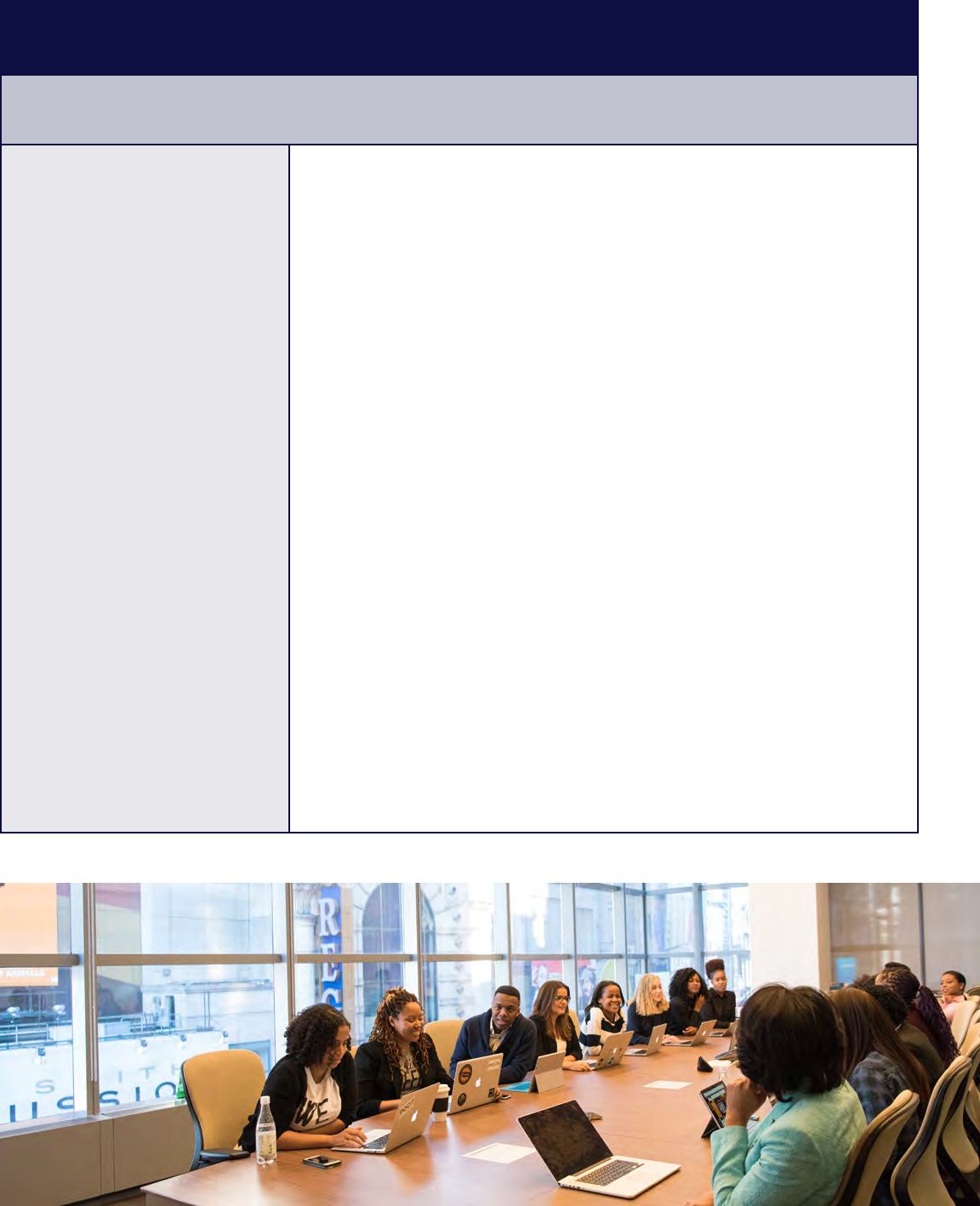
27
ACTIVITIES
• What actions did you take to address the broader societal issue?
In this section, state your
research methods briefly.
Then provide a description
of how you interacted or
communicated with societal
partners through your research.
Floodsville Project Activities:
• Downscaled climate and sea level rise projections to the scale of
Floodsville and the surrounding region.
• Attended 4 meetings with city planners and emergency managers during
the winter and spring of 2017. We presented our research (using maps) at
each meeting and engaged in discussions with decision makers about the
research process as well as implications of our findings.
• City officials called us regularly throughout their planning process to
confirm their understanding of the research (March – November 2017).
• Attended two community association meetings focused on the flood event
and community plans for flood relief (summer 2017). Answered questions
about projections of future flood events linked to sea level rise.
• Conducted two focus groups with community members (one with 10
participants and one with 8), one focus group with city planners (5
participants), and one with emergency managers (8 participants). All
occurred in spring and summer 2017. These focus groups helped us
understand the scale of analysis that was most helpful to all three groups,
how to present the data, and made us more aware of questions and
concerns of the community members.
• Provided city officials and community members with detailed maps
and summaries of our analysis during a presentation with each group
(December 2017).

28
OUTPUTS
• What did you produce through your research?
Briefly describe your research
findings. Then write out the tangible
research outputs you produced.
If you anticipate producing more
outputs (such as a peer-reviewed
article) note that here as well.
Your outputs could take many
forms, such as: data analyses and
models; public outreach materials;
white papers and peer-reviewed
articles; teaching curricula or
training materials; reports tailored
to specific audiences; websites; or
fact sheets.
Floodsville Project Outputs:
Findings: We found that the City’s current sea wall was not high
enough for the current sea levels or future levels. We provided
estimates to inform the height of a new wall.
Products:
• Downscaled climate projections for the Greater Floodsville region.
• Maps of projected sea level rise in the region – maps comply with
FEMA data standards for easy use in planning documents.
• Presentations summarizing research findings provided to
city planners.
• Two-page factsheet, aimed at community audience, summarizing the
research and addressing questions and concerns raised by community
members at meetings.
• A peer-reviewed publication has been submitted.
IMPACTS
• What changed as a result of your activities, your interactions with the public and your research
partners, and your outputs?
• For whom did things change or who changed because of your research?
In this section, identify what your project activities and outputs did for your societal partners. Think through
how your activities led to certain outputs, and how your activities and outputs contributed to change. In
reviewing your original research design, did you have the type of impacts you anticipated? Did you have any
unanticipated impacts?
Begin your description of impacts with one of the impact categories we introduced above: conceptual impacts –
new knowledge or awareness, connectivity impacts – partnerships established or strengthened, capacity building
impacts – skills or expertise strengthened or acquired, and instrumental impacts – direct applications of research.
Identify for whom things changed because of your research. This list may include resource management agency
representatives, policy makers or government officials, community members, industry professionals, students, or
members of the general public. You might also consider the demographics of the people who were impacted by
your research. Did your research impact the audiences that you aimed to reach?

29
IMPACTS CONTINUED
Floodsville Project Impacts:
Conceptual impacts:
• Our research team received emails from city council about their increased understanding about the risks of sea
level rise.
• Community members asked increasingly in-depth questions about the impacts that they might face, and used
this to think about new ways they would prepare for floods
People impacted: Floodsville community members from a neighborhood that had historically been underfunded
for infrastructure improvements by the Floodsville city government; Floodsville city councilmembers.
Capacity building impacts:
• A city council member used our Powerpoint presentation files to give a presentation to another city that was
recently flooded.
• Floodsville City Government gave staff members time to learn GIS skills from our research team in our lab
facilities, which helped them to be able to map the projections. This was a new skill set for the staff.
People impacted: Floodsville city government staff members.
Connectivity impacts:
• We built new relationships with city planners and community members.
• Our existing relationships with emergency managers were strengthened.
• The city planners invited us to do a new project about implementing green infrastructure.
• Our research team continues to get requests from the city for presentations.
People impacted: Floodsville community members; Floodsville city planners and emergency managers; members
of the project research team.
Instrumental impacts
• The new projection maps were used in the city’s new multi-hazard mitigation plan.
• The city’s multi-hazard mitigation plan was accepted by FEMA.
People impacted: Floodsville city government officials.
Long-term socio-ecological impacts (assessed using long-term evaluation process)
• 25 years later, sea level rise of 1 meter occurred, but flooding of the town was avoided
• Floodsville saved $5 billion USD by implementing actions from their hazard mitigation plan

30
EVIDENCE OF CHANGE
• How do you know that your research changed things for people?
Here, you can cite evidence that shows how
your research was used or how things changed
because of your research. Some examples of
evidence include:
Feedback from your partners
• Formal (letters of recommendation or
partnership)
• Informal (email or phone calls)
Reference to your work in a management/
policy document
• Citation to support statements
• Research findings forming the basis of
policy document
• Citation in management reports or publications
Feedback from the general public
• Audience surveys
• Emails or other engagement from public
• Media interviews/reference to your work
Formal evaluation of your work
• Randomized control trials
• Pre-post tests
• Surveys/interviews of partners
Floodsville Project Evidence of Change:
• City of Floodsville Multi-hazard Mitigation Plan. 2018.
Floodsville Department of Emergency Management.
• City of Floodsville Long-Range Infrastructure Plan. 2018.
Floodsville Department of Planning.
• Documents available online at:
floodsvillestoppedflooding.gov
• Emails from community members
and government employees
• Qualitative data from a survey distributed to city
employees and community members
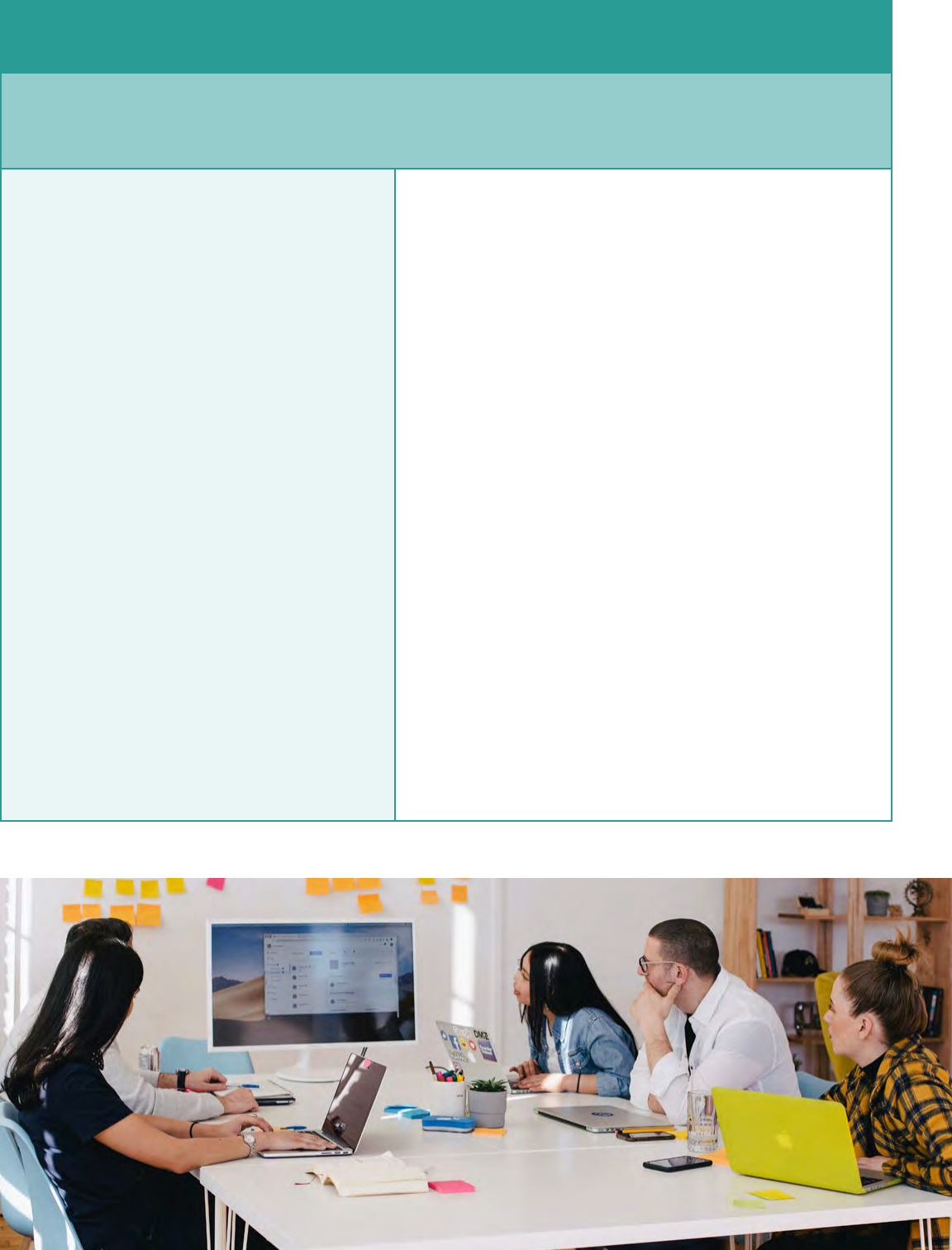
31
PROJECT REFLECTION AND REVIEW
• What resources and factors enabled this project and your research impacts?
• What components of the research were effective and which ones were not as effective?
Once you have completed outlining your
research impacts, you may want to reflect on
the parts of your project that were effective
and those that were not effective. Write down
some of the resources you had available
that enabled your research. Think about the
environmental, social, and political factors
that helped or hindered your research. Some
examples include:
• Process oriented factors – the way the
problem was framed; project management;
the way findings were disseminated; outputs
matched partner needs
• Inputs – key skill sets, funding, and
resources of the research team
• External factors – the political, economic, or
social context supported, or did not support,
action or change
Floodsville Project Review:
Overall, our project turned out to be effective. After the flood,
the City looked back at their hazard mitigation plan regarding
flooding and decided to update it. They want to keep in touch
about future updates to sea level rise projections. Residents
in the neighborhood that experienced flooding feel prepared
to deal with future risk and have more trust in the city’s
multi-hazard mitigation plan to reduce their future risk.
Some of the inputs that helped enable our project include:
• The knowledge and capacity on our research team to
provide projections
• Funding for research and engagement with partners
• Existing relationships between researchers an Floodsville
City Emergency Managers
Some of the context that enabled our project include:
• A flood event happened which galvanized
action in the city
• Community members were motivated to address the issue
• The city made it a priority to update their hazard plans

32
2.3
Documenting Impacts –
Worksheets and Case Studies
PROJECT TITLE:
Societal or Environmental Issue:
What societal problem do you aim to address in your research?
• Summarize your problem statement in 1 – 2 sentences
• Different from your research questions and research objective
• Address who is affected by this societal problem
Inputs
What resources are available or necessary to conduct your research?
What are the interests and motivations of each member of your research team?
• Describe the resources that you have available or will need to conduct your research
• Define your research team, and the skills, types of knowledge, and expertise each member offers to the project
• Identify the societal impact goals that motivate each research team member to be part of the research project
This section contains worksheets filled with guidance and additional case study examples to help you plan and
document your own research impacts. The first set of worksheets pertain to the Societal Impacts Framework for
Project Planning and Design. The second set of worksheets are based on the Societal Impacts Framework for Impact
Assessment and Project Reflection.
Societal Impacts Worksheet for Project Planning and
Design Guidance Document
Click here to download your own worksheet template for project
planning and design in Google Drive.

33
PROJECT CONTINUED:
Anticipated Activities
What actions will you take to address the societal issue?
• State your research methods
• Outline roles and responsibilities for each member of the research team
• Describe how the research team will engage and communicate with one another during the project
• Outline the activities that will take place throughout the project
Anticipated Outputs
What do you plan to produce through your research?
• Observations and data
• Tangible research outputs might include:
• Public Outreach Materials
• Models/Datasets
• Reports for Partners
• Fact Sheets
• Websites
• Peer-reviewed articles
• Curricula
• Others
Anticipated Impacts
What do you expect to change as a result of your activities, your interactions with partners, and your project
outputs?
• Conceptual outcomes - new knowledge or awareness gained
• Connectivity outcomes - partnerships established or strengthened
• Capacity Building outcomes - skills, expertise strengthened or acquired
• Instrumental outcomes - direct applications of research
For whom do you expect things will change?
Evidence of Impact
How will you know that things have changed?
• Describe your plan to collect, document evidence of change. Some examples include:
• Feedback from your partners
• Reference to your work in management or policy documents
• Feedback from the general public
• Formal evaluation of your work

34
PROJECT TITLE:
The Influence of Temperature and Soil Moisture on Colorado River Water Resources
Societal or Environmental Issue:
The U.S. Southwest is an arid region and is becoming hotter and drier due to climate change. Climate model-based
temperature projections indicate Colorado River streamflow reductions of 20 percent by 2050 and 35 percent by
2100. Approximately 40 million people in the western U.S. and northwestern Mexico rely on Colorado River water for
domestic, industrial, and agricultural uses.
This project aims to better understand how temperature has influenced Colorado River water resources. Water
resource managers who work in the Colorado River Basin will use this information to inform resource management
plans and operations, which has implications for people, cities, and ecosystems across the Southwest.
Inputs
To develop the proposal, we have engaged with a group of Colorado River basin water managers who have
assisted in directing research questions and ensuring the project is relevant to resource management. This group
of water managers will form an advisory board to guide the analysis and generation of research products through
interaction with the science team. The members of the advisory board have long-standing relationships with
members of the science team from previous research engagements. They are interested in using the research
findings for their own purposes, and are informing the project design, but are not interested in collecting or
analyzing data.
The science team will be collecting and analyzing the data and communicating findings to the advisory board. The
science team is an interdisciplinary group with expertise in climatology, paleoclimatology, hydrologic modeling, and
climate projection analysis, with extensive experience working with resource managers. The members of the team
want to apply their expertise to address water management issues in the Southwest. One member of the team
will be using part of this research for her dissertation.
This project has funding for 2 years.
Anticipated Activities
• Engagement activities include:
• quarterly meetings with the advisory board
• email and phone calls between science team and advisory board members as needed
• a final project workshop with water resource managers
The science team will meet monthly to discuss project updates and will communicate as needed
by phone and email.
Societal Impacts Worksheet for Project Planning and Design
Case Study Example

35
The Influence of Temperature and Soil Moisture on Colorado River Water Resources
Anticipated Outputs
• Analysis of instrumental data
• Analysis of tree-ring chronologies
• Soil moisture model
• Project website, kept up to date as research is completed
• Quarterly reports to advisory board
• Presentations to academic audiences
• Workshop with water resource managers
• Final report for water resource managers
• Academic publication
Anticipated Impacts
• Inform decision making and planning for water management and conservation measures, by providing
information about the roles seasonal precipitation, temperature, and antecedent moisture conditions
• Raise awareness of possible impacts of warming temperatures on drought and expected runoff
now and in the future
• Increase awareness about how to use tree-ring data for future planning, recognizing t that the past
is not an analog for the future
• Increase awareness about the climate connections between winter precipitation and fall and spring
temperatures in the Colorado River Basin
Evidence of Impact
• Annual interviews with members of the advisory board about the research process and how they have used
or plan to use project findings
• Interviews with members of the science team about the research process, research findings, and
implications of their findings
• Feedback from workshop participants via online survey
• Evidence from emails and feedback from advisory board about use of information

36
PROJECT TITLE:
Summary Statement of Impacts
Return to this section after you have completed the rest of the worksheet.
Summary of the Research
What societal problem did you aim to address in your research?
• Summarize this problem statement in 1 – 2 sentences
• This is likely to be different from your research questions and your research objective
• Be sure to address who is affected by this societal problem
Project Engagement Activities
What actions did you take to address this issue?
• State your methods briefly to give a sense of the kind of research you did
• Provide a description of your approach to societal engagement
Research Outputs
What did you produce through your research?
• BRIEFLY describe your research findings
• Tangible research outputs:
• Public Outreach Materials
• Models/Datasets
• Reports for Partners
• Fact Sheets
• Websites
• Peer-reviewed articles
• Others
Societal Impacts Worksheet for Project
Reflection and Impact Assessment
Guidance Document
Click here to download your own worksheet template
for project planning and design in Google Drive.

37
PROJECT CONTINUED:
Details of Impacts
What changed as a result of your activities, your interactions with partners, and your outputs?
• Conceptual Impacts - new knowledge or awareness gained
• Connectivity Impacts - partnerships established or strengthened
• Capacity Building Impacts - skills, expertise strengthened or acquired
• Instrumental Impacts - direct applications of research
For whom did things change?
Evidence of impact
Examples of evidence of change
• Feedback from your partners
• Formal (letters of recommendation or partnership)
• Informal (email or phone calls)
• Reference to your work in a management/policy document
• Citation to support statements
• Research findings forming the basis of policy document
• Citation in management reports or publications
• Feedback from the general public
• Audience surveys
• Emails or other engagement from public
• Media interviews/reference to your work
• Formal evaluation of your work
• Randomized control trials
• Pre-post tests
• Surveys/interviews of partners

38
PROJECT TITLE:
Climate Change and Regional Fish Management
Summary Statement of Impacts
We worked closely a coalition of natural resource managers to identify the cumulative impacts of climate change,
habitat degradation, and invasive species on an important fish species in this region. Based on this research,
the coalition was able to prioritize funding for management of this species. In addition, a federal resource
management agency used the findings to inform its decision to build a physical barrier to protect the key species
from an invasive competitor.
Summary of the Research
This project used a novel modeling approach to develop multi-species climate change vulnerability assessments,
which offer the ability to relatively rank and prioritize populations of multiple sympatric species. We concluded
that climatic drivers, which are damaging the species’ habitat, as well as introduction of an invasive species are
contributing to the loss of the focal species in the region.
Project Engagement Activities
The lead researcher worked closely with the coalition group. The coalition’s mission is to support the management
of ecologically significant species in this region through building awareness and sharing best practices between
and among federal and state natural resource management agencies in the region. The researcher attended
coalitions meetings approximately 3 times each year during the project (2016 – 2018) and co-convened a workshop
with the coalition (Summer 2018) where they elicited feedback from other regional resource managers about early
project findings.
The researcher and the coalition leaders communicated regularly by phone and email, at least every month. The
coalition team members remarked on how often the researcher attended their general meetings.
Research Ouputs
• Several scientific papers analyzing the extent to which the focal species is affected by invasive fish species in
the region and the rate of habitat degradation expected due to climate change.
• Maps of currently stressed and fragmented habitat areas.
• Maps of areas likely to become more stressed in the future due to climate change impacts.
• Maps of presence of focal species and invasive species.
• All maps were integrated into an existing decision support tool used regularly by
resource managers in the region.
Societal Impacts Worksheet
Case Study Example Document
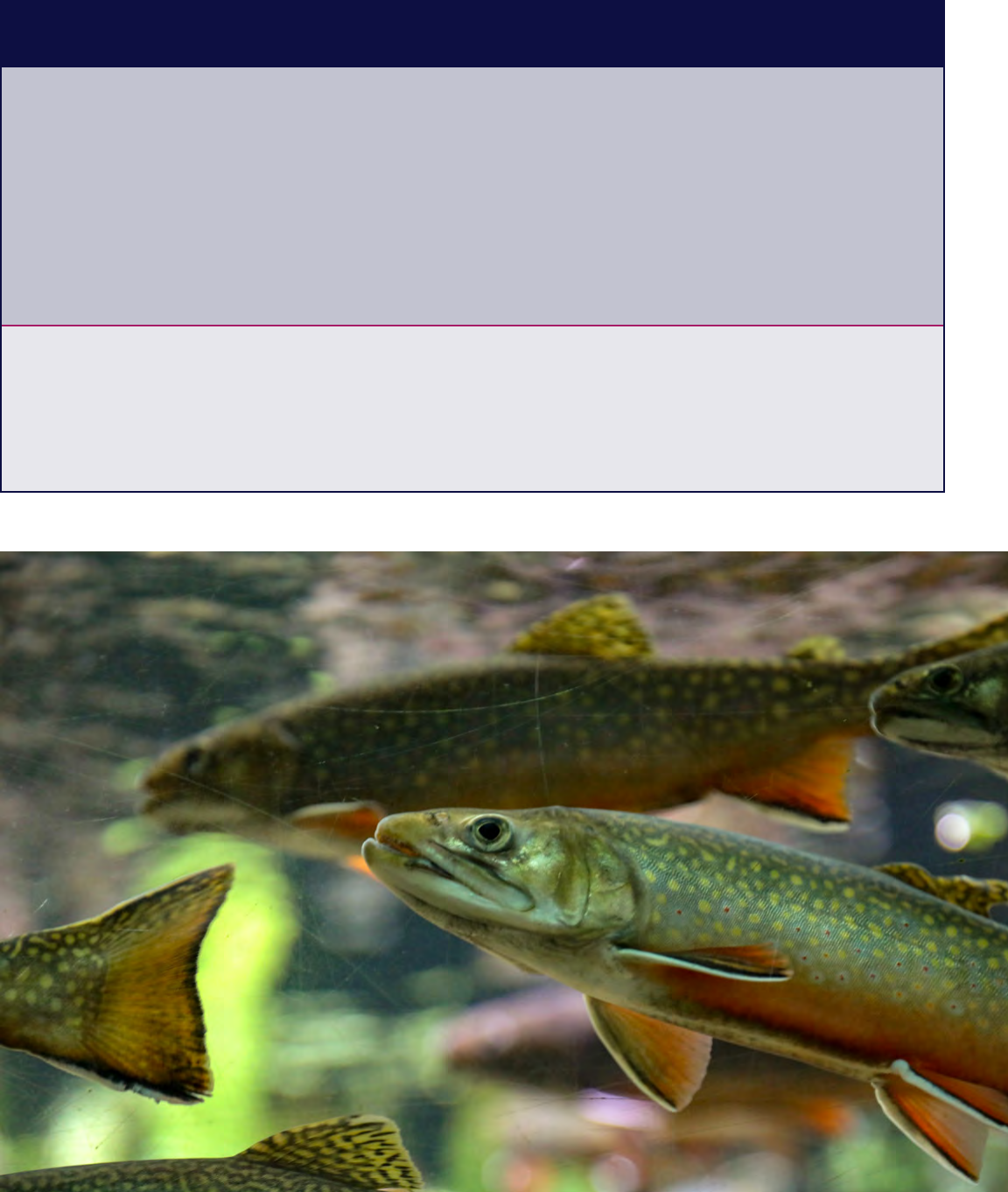
39
Climate Change and Regional Fish Management continued
Details of the Impacts
• The management coalition used our research findings as part of its decision to prioritize funding for
management of the focal species. They reallocated available resources to their efforts to restore habitat
in the region.
• A federal agency used the findings to inform its decision to build a physical barrier at one key location (identified
through our work) to protect the focal species from its invasive competitor.
Sources that corroborate the Impacts
• Regional Aquatic Species Management Coalition Strategic Plan 2018 – 2023.
• Federal Agency Species Management Plan 2019.
• Environmental Impact Statement regarding placement of physical barrier at No Invasives Creek. 2018.
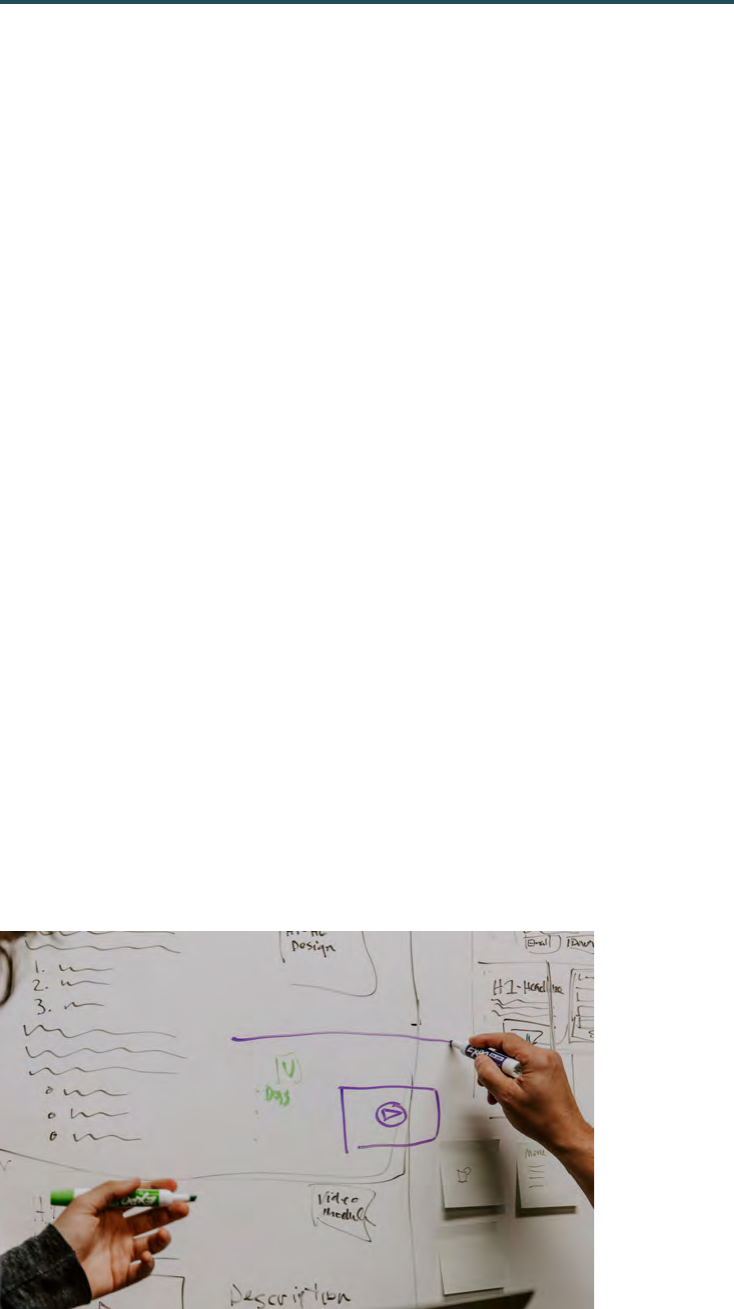
40
Appendix A: Exploring Societal
Impacts Categories
A number of different impact categories have been
developed for use in different contexts. Many people
use a common core of impact types but refine or add
new categories to better suit a particular use. There are
good reasons to rely on a common typology, such as the
ability to compare and contrast projects, programs, and
organizations, and to provide consistency over time to
measure progress in achieving impact goals. However,
because the societal benefits accruing from research
are highly context-dependent (i.e. different communities,
decision makers, or policy makers need different things),
retaining the ability to demonstrate impacts in ways that
reflect the true societal benefits is important. Below we
summarize some of the common impacts definitions in
order to provide options and ideas for researchers looking
for appropriate descriptions of their work.
A standard typology, that emerged from policy studies
(Weiss 1973; Pelz 1978), and has been applied to societal
impacts assessments (Walter, Davies, and Nutley 2003;
Meagher, Lyall, and Nutley 2008; Meagher and Martin 2017),
focuses on two core categories of impact:
• Instrumental impacts - direct impacts of research on
policy and practice decisions where a specific piece
of research is used in making a specific decision or in
defining the solution to a specific problem
• Conceptual impacts - complex and indirect ways in
which research can have an impact on the knowledge,
understanding, and attitudes of policy makers and
practitioners.
Kuruvilla et al (2006) designed the Research Impact
Framework as a tool to assist researchers in documenting
their own impacts and added two additional impacts that
has also previously been described by Weiss (1998):
Mobilization of support - research findings provide
persuasive evidence to back ongoing and proposed
policy activities or raise awareness and support for new
policy-making. Also termed symbolic or justification by
Pelz (1978).
Wider influence - research impacts that lead to a wide
change or transformation of accepted beliefs and
practices, beyond the use or impact to a specific, direct
societal partner.
PART 3.
Additional Context and Information
Part 3 contains four appendices that provide additional context and information about several of the topics introduced
in this guidebook. The appendices are intended to dive deeper into the academic literature on societal impacts, engaged
research approaches, and research evaluation for readers who wish to explore these topics in greater detail.
41
Meagher and Martin (2017) expanded impacts categories to include impacts with an indirect, but still traceable influence,
on use of research findings:
• Capacity building impacts - training and/or developing collaborative abilities
• Enduring connectivity - establishment of long-lived external relationships
• Attitude or cultural change - increased willingness to engage in knowledge exchange activities, on the part of
individuals, institutions, or organizations.
• The National Science Foundation (NSF) includes “broader impacts” as a key component of research it funds. NSF’s
categories tend to emphasize improvements to the broader science enterprise through:
• Full participation of women, persons with disabilities, and underrepresented minorities in STEM
• Improved STEM education and educator development at any level
• Increased public scientific literacy and public engagement with science and technology
• Development of a diverse, globally competitive STEM workforce
• Increased partnerships between academia, industry, and others
• Enhanced infrastructure for research and education
The list of NSF impact examples also includes:
• Improved well-being of individuals in society
• Improved national security
• Increased economic competitiveness of the United States
Process as an Indicator of Impacts
Researchers also recommend evaluating the process of engagement as a key indicator of the likelihood of generating
impacts (see Appendix B for a more detailed discussion of this process). The Social Impact Assessment Methods for
research and funding instruments through the study of Productive Interactions (SIAMPI) framework was developed
by Spaapan and van Drooge (2011) to evaluate the return on investment of European Union-funded research. They
recommended documenting productive interactions between researchers and societal partners in three categories:
• Direct interactions - ‘personal’ interactions involving direct contacts between humans, interactions that revolve
around face-to-face encounters, or through phone, email or videoconferencing (i.e. research findings and processes
are conveyed directly between researchers and societal partners).
• Indirect interactions - contacts that are established through some kind of material ‘carrier’, for example, texts, or
artefacts such as exhibitions, models or films (i.e. research findings are transferred through a report, article, or
other media).
• Financial interactions - when potential partners engage in an economic exchange with researchers, for example, a
research contract, a financial contribution, or a contribution ‘in kind’ to a research program.
Similarly, Ford et al. (2013) link the likelihood of impacts to the extent to which the research has been intentionally
co-designed with decision makers. They note that all types of research, including basic or fundamental science as well
as applied or action-oriented science, have the potential to influence policy, inform decisions, and alert the public to
potential problems; but only “usable science” – or research that is explicitly designed to contribute to decision making
processes and have the characteristics of pertinence, quality, and timeliness – does so directly.
42
Impacts in Context
All research impacts are context-dependent (Boaz, Fitzpatrick, and Shaw 2009; Mach et al. 2020); they will differ
depending on the project goals, sector, processes, and participants. Thus, while maintaining a common core of impacts
categories is valuable for consistency and comparison, allowing for flexibility in reporting structures is crucial to ensure
that the impacts most important to societal partners are prioritized. For example, Reed (2018) presents a more fine-
grained list of impact categories, intended to help researchers plan and document their own impacts. In addition to
his categories for capacity/preparedness, understanding and awareness, attitudinal, and policy (which align well with
capacity-building, conceptual, and instrumental impacts), he suggests:
• Economic – monetary benefits arising from research
• Environmental – benefits from research to genetic diversity, species or habitat conservation, ecosystems, and
ecosystem services
• Health and well-being – research that leads to better outcomes from the health of individuals, social groups, or
public health.
• Cultural – changing in the prevailing values, attitudes, beliefs, discourse and patterns of behavior
A caveat to using pre-defined categories: Fazey et al. (2014) and Wiek et al. (2014) point out that while it is possible to
anticipate some impacts, it is important to be open to unanticipated or unintended outcomes. Unexpected results can
provide additional insights into the possibilities for future impacts.
Summary
There is some coalescence around a common core of impact categories, particularly in frameworks developed for use by
European research institutions, who are more likely to have mandated reporting of societal impacts. This common core
– instrumental, conceptual, capacity-building, and connectivity – can be beneficial when seeking to compare research
projects, program, and organizations or when seeking to track progress in meeting impact goals over time. However,
in order to accurately capture the impacts from diverse research and investigators, maintaining flexibility within
frameworks is important. Space should be maintained for unanticipated or unexpected impacts or for describing impacts
that do not immediately fit a pre-defined category. Exploring alternative impacts categories can help researchers identify
the breadth of categories they may generate and provide ideas for framing and describing impacts.
43
Appendix B: Socially Engaged Research
As noted throughout this guidebook, one pathway to
generating societal impacts is through direct interactions
between researchers and societal partners throughout
the research process. This pathway stems from decades
of development in the theory and practice of socially-
engaged research.
In the U.S., the conceptualization of how science brings
about innovation and social change can be traced
back to the post World War II era when the first clear
articulation of non-war federal science policy was put
forward by Vannevar Bush (Guston 2001). The vision
that Bush formulated in a report to President Truman—
Science, the Endless Frontier (1945)—emphasized the
need for government support for science to continue
during post-war times. Research and technology, he
believed, would spur innovations in health, agriculture,
national security, and other forms of public welfare.
But Bush also emphasized that the “freedom of inquiry
must be preserved. As long as universities are vigorous
and healthy and their scientists are free to pursue the
truth wherever it may lead, there will be a flow of new
scientific knowledge to those who can apply it to practical
problems in Government, in industry, or elsewhere” (1945).
This vision of science policy was originally developed
to maintain scholarly independence from government
or corporate influence (Dennis 2015). It assumes that
discoveries made by academic experts will be delivered
to members of society who will use the results to inform
policy, practice, and technology (Cash, Borck, and Patt
2006). However, the model does not explain how scientific
results will be delivered, consumed, or used. Evidence has
accumulated to indicate that when research is separated
from its intended users (such as in the loading-dock
model described by Cash et al. 2006), it is not often used
in practice and policy. For example, Bornmann et al. (2016)
found that only 1.2% of climate science research produced
between 1980 and 2014 was cited in international climate
policy documents.
In response to this gulf between research and practice,
new modes of research have evolved. These new modes
can be broadly categorized as socially engaged research.
Various approaches and methods within this vein include
action research (Lewin 1946; Greenwood and Levin 2007);
post-normal science (Funtowicz and Ravetz 1993); Mode 2
knowledge production (Gibbons et al. 1994; Nowotny, Scott,
and Gibbons 2001); boundary work (Guston 2001; Cash et
al. 2003); knowledge coproduction (Jasanoff 2004; Lemos
and Morehouse 2005); transdisciplinarity (Pohl 2008; Jahn,
Bergmann, and Keil 2012); transformational sustainability
science (Kates et al. 2001; Wiek et al. 2012); social learning
(Wenger 2010; Pahl-Wostl et al. 2007); and useful science or
usable knowledge production (e.g. Dilling and Lemos 2011;
Clark et al. 2016; Mach et al. 2020). See the table below
for brief descriptions. These frameworks converge and
diverge in terms of agenda and approach. However, they
all make one thing clear: physical and social scientists
must collaborate with people outside of the
academic realm if they want their research to inform
policy or create societal and environmental change.
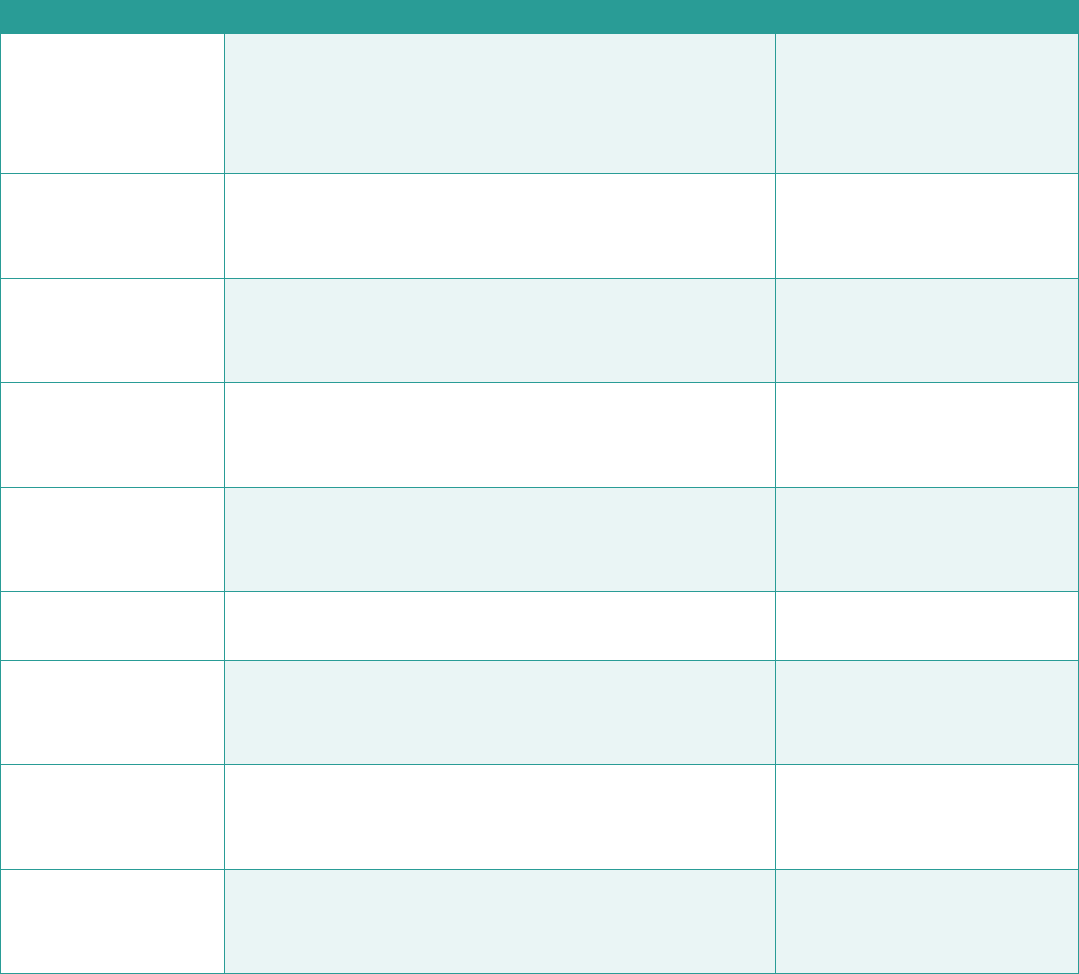
44
Socially engaged research concepts
Research concept Description Exemplary citations
Action research Research primarily defined and driven by stakeholders.
Researchers support, facilitate, and provide technical input.
Objectives aim to effect
change in a stakeholder community.
Lewin 1946;
Greenwood and Levin 2007
Post-normal science Motivated by societal issues and needs rather than
researcher curiosity. Relies on participation of a ‘peer
community’ that extends beyond scientists.
Funtowicz and Ravetz 1993
Mode 2 knowledge
production
Contextualized by the societal factors surrounding a
particular issue and characterized by the inclusion of multiple
types of knowledge and research partners.
Gibbons et al. 1994;
Nowotny et al. 2001
Boundary work Aims to solve real-world issues through dialog and
collaboration across the ‘boundaries’ between scientific
experts and decision makers.
Guston 2001;
Cash et al. 2003
Knowledge
coproduction
Iterative engagement between researchers and nonacademic
partners will produce innovative, scientifically-robust, and
useful knowledge for real-world applications.
Jasanoff 2004;
Lemos and Morehouse 2005
Transdisciplinary
research
The integration of multiple types of expertise and knowledge
is necessary to address a common issue.
Pohl 2008;
Jahn et al. 2012
Transformational
sustainability science
Incorporates knowledge from outside academia into research
processes to support the creation of sustainable social
systems.
Kates et al. 2001;
Wiek et al. 2012
Social learning Social processes help create mutual understandings between
two or more parties, through which individual and societal
transformations can occur.
Wenger 2000;
Pahl-Wostl et al. 2007
Useful science, usable
knowledge
Research conducted to produce knowledge that is useful,
usable, and actually used by societal members.
Dilling and Lemos 2011;
Clark 2016;
Mach et al. 2020

45
Socially engaged research is more effective than indirect
research pathways in transitioning research into policy
and practice and generating societal impacts. By virtue of
the direct engagement between researchers and societal
partners, and incorporating partners’ perspectives and
knowledge into the research process, the research better
fits the decision contexts in which it will be used (Mach
et al. 2020). The process of engagement helps to build
relationships and trust between societal partners and
researchers (Kothari et al. 2011), which makes it more likely
that partners will find the research credible and usable
(Cash et al. 2003; Lacey et al. 2018; Association of Public
and Land-Grant Universities 2019). The research findings
are more accessible to societal partners both conceptually,
because the research process does not occur in a black
box (Jasanoff and Wynne 1998), and physically, because
the findings are do not sit behind academic pay-walls
(Cvitanovic et al. 2019). A principle of socially engaged
research is that it should include multiple knowledges and
values (Norström et al. 2020; Reed and Meagher 2019). This
inclusive process helps to make the outputs and outcomes
more applicable and acceptable to societal partners,
particularly those who have historically been excluded
from both research and decision making processes (David-
Chavez and Gavin 2018; Association of Public and Land-
Grant Universities 2019).
Studies of the outcomes of socially engaged research
show that the approach is particularly strong in terms
of fostering learning (conceptual impacts), strengthening
community (connectivity impacts), and using research
findings in policy or practice documents (instrumental
impacts) (Cvitanovic et al. 2019; Jagannathan et al. 2020). As
we note throughout this document, although expectations
for long-term socio-environmental change are embedded
within many discussions of socially engaged research
(Jagannathan et al. 2020), those changes are harder to
generate in the short- and medium-term and are harder to
identify and trace in the longer term.
46
Appendix C: Challenges of Impacts Assessment
There are two main sets of challenges associated with evaluating research impacts. The first set has to do with
the nature of knowledge generation and the use of knowledge and information. The second set deals with the
methodological barriers to identifying and quantifying the full range of possible impacts emerging from research.
Knowledge Generation and
Information Use
The nature of knowledge generation and use poses
significant challenges for tracing clear lines from a
particular research project to societal impacts. There
is often a significant time lag between when research
results emerge to when practitioners adopt new practices
(Bell, Shaw, and Boaz 2011; Penfield et al. 2014; Spaapen
and van Drooge 2011). For example, in medical research,
this lag can be up to 17 years (Moore et al. 2016). The lag
can be attributed to several factors, such as whether
an organization is prepared to integrate new knowledge;
the level of uncertainty surrounding new knowledge;
and the pertinence of the new knowledge to the specific
needs of the practitioners (Ford, Knight, and Pearce 2013;
Green et al. 2009; Oh and Rich 1996). The need for an
organization to be ready to use new information – and
the need for new information to be ready to use – and
the resulting time lag makes it more difficult to trace the
influence of one particular piece of research on a decision
or action (Bell, Shaw, and Boaz 2011; Boaz, Fitzpatrick, and
Shaw 2009; Penfield et al. 2014; Spaapen and van Drooge
2011; Wiek et al. 2014). Researchers can use contribution
analysis to gauge the extent to which research has
influenced practitioner decisions. Using a contribution
framework allows researchers to acknowledge the
complexities involved in creating societal change, while
also pointing to the ways that individual research efforts
(and researchers themselves) help the process of change
(Morton 2015). In addition to contribution analysis, using
multiple categories of impact, including the categories
presented in this guidebook, is an effective approach to
identifying the ways a research project helps influence
new thinking and behaviors while acknowledging that
systemic change (whether social or ecological) may
require additional time and inputs.
Methodological Barriers
Collecting tangible pieces of evidence can sometimes be
straightforward — for example, if an organization cites
your research findings as justification for a new policy
change. In other cases, identifying less-tangible impacts
can pose some methodological challenges to those
unfamiliar with using qualitative data. Conceptual impacts,
such as changes in understanding or attitude, are most
likely to be identified through qualitative assessment
methods that allow project participants to reflect in an
open-ended fashion on their experiences. Unanticipated or
unexpected impacts are also more likely to be identified
through open-ended qualitative inquiry (Spaapen and van
Drooge 2011; Meagher and Martin 2017).
Addressing these methodological challenges will depend
on the resources and time available for evaluation
(Bell, Shaw, and Boaz 2011). Rigorous qualitative data
collection and analysis can help to identify impacts and
understand the context in which they were generated.
The most common societal impacts reporting frameworks,
the Research Excellent Framework (UK), the Standard
Evaluation Protocol (Netherlands), and the Australian
Engagement and Impact Assessment all use a case study
approach to collecting impact reports. Case studies
are reviewed by panels of experts, usually made up of
a mix of researchers and societal partners. While more
time consuming than quantitative assessments, these
qualitative approaches provide a more realistic and richer
understanding of the role of research in societal change.
Another methodological challenge is related to the time
lag issue discussed above. Because it can take several
years for research to move into use and impact, details
about how and why it was able to generate such impacts,
particularly questions related to engagement processes
and participation, may be lost along the way (Bell, Shaw,
and Boaz 2011; Wiek et al. 2014) . Over time, memories
47
fade or events are re-interpreted by participants and it
can be challenging to reconstruct the details of particular
projects and decisions. It can also be challenging to
secure the participation of researchers and practitioners
in evaluation processes, particularly after projects have
ended and the participants have moved on to other
matters (Wall, Meadow, and Horangic 2017; Wiek et al. 2014).
These challenges can be overcome through on-going and
embedded evaluation approaches that follow projects
throughout their lifetimes and maintain contact with
participants.
Finally, the lack of baseline data on how and under what
conditions and at what frequency research has specific
societal impacts hinders our ability to evaluate project
success (Penfield et al. 2014; Jagannathan et al. 2020). This
challenge may be self-correcting as interest in societal
impacts grows and more data is generated about the
current state of impacts
Appendix D: Concerns about
Societal Impacts Evaluation
As societal impacts reporting and evaluation has gained
traction, it has also raised some concerns within the
research community. A societal impacts approach to
academic evaluation represents a significant shift for
many institutions and researchers. Instead of being
evaluated solely on the scientific rigor and significance of
their work, it requires demonstrating the significance of
their research outside of the academic realm.
Some researchers have expressed concern that
emphasizing societal impacts will effectively devalue basic
research and divert resources away from research that
is focused on “blue skies” questions and grand scientific
challenges (Chubb and Reed 2018; Watermeyer and Chubb
2019; Stern 2016). In a similar vein, some are apprehensive
that evaluation of their research impacts will threaten
their academic freedom by allowing external forces to have
more control over research agendas. Some researchers,
for example, express concern that government-funded
evaluations of government-funded research may be a
tool to suppress research critical of government policies.
Their concern may be related to fears about breaking
down the boundaries between science and society in
ways that some researchers perceive will dilute the
integrity of scientific research (Cvitanovic et al. 2019).
However, this critique perhaps overlooks the fact that
funding agencies have always had significant influence on
research agendas, and that societal values and interests
have always influenced which scientific research is valued,
funded, and undertaken (Greenwood and Levin 2007).
These concerns are not raised solely by the introduction of
societal impacts measures.
A more practical concern is the societal impacts reporting
may be required on top of current evaluation practices.
Most academic researchers are evaluated based on the
academic impacts of their work – as measured by the
number of publications and citations. The accuracy and
appropriateness of these academic metrics have been
challenged on multiple fronts (Adler and Harzing 2009;
Alvesson, Gabriel, and Paulsen 2017; Hicks et al. 2015), but
they have proved quite durable thanks to their relative
ease of use. Given the importance of academic metrics,
the move to societal impacts reporting can feel like an
added burden – and one with little payoff if the effort is
not directly linked to formal performance evaluation or
promotion and tenure policies.
Societal impacts evaluation and reporting does not seek to
supplant research excellence. Quite the opposite – societal
impact practices recognize that the foundation of societal
impacts is high quality research. Engagement with societal
partners, often a key component in generating societal
impacts, does not negate the need for rigor in scientific
methods or processes (Cvitanovic et al. 2019; Greenwood
and Levin 2007). Societal impacts reporting provides
opportunities for researchers who do socially engaged
research to be recognized and evaluated based on a more
accurate portrayal of the work they do – research that
involves scientific rigor plus additional time and resources
for direct engagement with societal partners. Societal
impacts reporting can become less of an additional burden
on researchers once the practice is fully integrated into
academic performance measures. It will help ensure that
researchers receive credit for the work of generating
societal impacts and the work of documenting, evaluating,
and reporting them.
48
References
Adler, Nancy J, and Anne-Wil Harzing. 2009. When knowledge wins: Transcending the sense and nonsense of academic
rankings. Academy of Management Learning & Education 8 (1):72-95.
Alvesson, Mats, Yiannis Gabriel, and Roland Paulsen. 2017. Return to meaning: A social science with something to say:
Oxford University Press.
Association of Public and Land-Grant Universities. 2019. Public Impact Research: Engaged Universities Making The
Difference. Washington, DC: Association of Public and Land-Grant Universities.
Bell, Sarah, Ben Shaw, and Annette Boaz. 2011. Real-world approaches to assessing the impact of environmental
research on policy. Research Evaluation 20 (3):227-237.
Boaz, Annette, Siobhan Fitzpatrick, and Ben Shaw. 2009. Assessing the impact of research on policy: a literature review.
Science & Public Policy (SPP) 36 (4):255-270.
Bornmann, Lutz, Robin Haunschild, and Werner Marx. 2016. Policy documents as sources for measuring societal impact:
how often is climate change research mentioned in policy-related documents? Scientometrics 109 (3):1477-1495.
Cash, D. W., J. C. Borck, and A. G. Patt. 2006. Countering the loading-dock approach to linking science and decision
making - Comparative analysis of El Nino/Southern Oscillation (ENSO) forecasting systems.
Science, Technology and Human Values 31 (4):465-494.
Cash, David W., William C. Clark, Frank Alcock, Nancy M. Dickson, Noelle Eckley, David H. Guston, Jill Jäger,
and Ronald B. Mitchell. 2003. Knowledge Systems for Sustainable Development.
Proceedings of the National Academy of Sciences 100 (14):8086-8091.
Chubb, Jennifer, and Mark S Reed. 2018. The politics of research impact: academic perceptions of the
implications for research funding, motivation and quality. British Politics:1-17.
Clark, William C., Lorrae van Kerkhoff, Louis Lebel, and Gilberto C. Gallopin. 2016. Crafting usable knowledge for
sustainable development. Proceedings of the National Academy of Sciences 113 (17):4570-4578.
Cvitanovic, Christopher, Mark Howden, RM Colvin, Albert Norström, Alison M Meadow, and PFE Addison. 2019.
Maximising the benefits of participatory climate adaptation research by understanding and managing the
associated challenges and risks. Environmental Science & Policy 94:20-31.
David-Chavez, Dominique M, and Michael C Gavin. 2018. A global assessment of Indigenous community engagement
in climate research. Environmental Research Letters 13 (12):123005.
Dennis, Michael A. 2015. Our monsters, ourselves: Reimagining the problem of knowledge in Cold War America.
Dreamscapes of modernity: Sociotechnical imaginaries and the fabrication of power:56-78.
Dilling, Lisa, and Maria Carmen Lemos. 2011. Creating usable science: Opportunities and constraints for
climate knowledge use and their implications for science policy. Global Environmental Change 21 (2):680-689.
Fazey, Ioan, Lukas Bunse, Joshua Msika, Maria Pinke, Katherine Preedy, Anna C. Evely, Emily Lambert, Emily Hastings,
Sue Morris, and Mark S. Reed. 2014. Evaluating knowledge exchange in interdisciplinary and multi-stakeholder
research. Global Environmental Change 25 (0):204-220.
49
Ford, James D., Maggie Knight, and Tristan Pearce. 2013. Assessing the ‘usability’ of climate change research for
decision-making: A case study of the Canadian International Polar Year. Global Environmental Change 23 (5):1317-1326.
Foster, Kevin Michael. 2010. Taking a stand: Community-engaged scholarship on the tenure track.
Journal of Community Engagement and Scholarship 3 (2):20.
Funtowicz, Silvio O., and Jerome R. Ravetz. 1993. Science for the post-normal age. Futures 25 (7):739-755.
Gibbons, M., C. Limoges, H. Nowotny, S. Schwartzmann, P. Scott, and M. Trow. 1994. The New Production of Knowledge:
The Dynamics of Science and Research in Contemporary Societies. London, UK: Sage.
Green, Lawrence W., Russell E. Glasgow, David Atkins, and Kurt Stange. 2009. Making Evidence from Research
More Relevant, Useful, and Actionable in Policy, Program Planning, and Practice: Slips “Twixt Cup and Lip”.
American Journal of Preventive Medicine 37 (6, Supplement 1):S187-S191.
Greenwood, Davydd J., and Morten Levin. 2007. Introduction to Action Research: Social Research for Social Change.
2nd ed. Thousand Oaks: Sage Publications.
Greenwood, Davydd, and Morten Levin. 2007. Scientific Method and Action Research In Introduction to Action Research.
Thousand Oaks, California: SAGE Publications, Inc.
Guston, David H. 2001. Boundary Organizations in Environmental Policy and Science:
An Introduction. Science, Technology, & Human Values 26 (4):399-408.
Hicks, Diana, Paul Wouters, Ludo Waltman, Sarah De Rijcke, and Ismael Rafols. 2015.
Bibliometrics: the Leiden Manifesto for research metrics. Nature News 520 (7548):429.
Jagannathan, Kripa, James C. Arnott, Carina A. Wyborn, Nicole Klenk, Katharine J. Mach, Richard H. Moss, and
K. Dana Sjostrom. 2020. Great Expections? Reconciling the aspiration, outcome, and possibility of co-production.
Current Opinion in Environmental Sustainability 42:22 - 29.
Jahn, Thomas, Matthias Bergmann, and Florian Keil. 2012. Transdisciplinarity:
Between mainstreaming and marginalization. Ecological Economics 79:1-10.
Jasanoff, Sheila, ed. 2004. States of Knowledge: The Co-production of Science and the Social Order,
International Library of Sociology: Routledge.
Jasanoff, Sheila, and Brian Wynne. 1998. Science and decisionmaking. In Human choice and climate change,
edited by S. Rayner and E. L. Malone. Columbus: Battelle Press.
Kates, Robert W, William C Clark, Robert Corell, J Michael Hall, Carlo C Jaeger, Ian Lowe, James J McCarthy,
Hans Joachim Schellnhuber, Bert Bolin, and Nancy M Dickson. 2001. Sustainability science. Science 292 (5517):641-642.
Kothari, Anita, Lynne MacLean, Nancy Edwards, and Allison Hobbs. 2011. Indicators at the interface:
managing policymaker-researcher collaboration. Knowledge Management Research & Practice 9 (3):203-214.
Kuruvilla, Shyama, Nicholas Mays, Andrew Pleasant, and Gill Walt. 2006. Describing the impact of health research:
a Research Impact Framework. BMC health services research 6 (1):134.
Lacey, Justine, Mark Howden, Christopher Cvitanovic, and R. M. Colvin. 2018. Understanding and managing trust
at the climatescience–policy interface. Nature Climate Change 8 (1):22-28.
50
Lemos, Maria Carmen, and Barbara J. Morehouse. 2005. The co-production of science and policy in integrated
climate assessments. Global Environmental Change 15:57-68.
Lewin, Kurt. 1946. Action research and minority problems. Journal of Social Issues 46 (2):34-46.
Mach, Katharine J., Maria Carmen Lemos, Alison M. Meadow, Carina Wyborn, Nicole Klenk, James C. Arnott,
Nicole M. Ardoin, Clare Fieseler, Richard H. Moss, Leah Nichols, Missy Stults, Catherine Vaughan, and
Gabrielle Wong-Parodi. 2020. Actionable knowledge and the art of engagement.
Current Opinion in Environmental Sustainability 42:30-37.
Meagher, Laura, Catherine Lyall, and Sandra Nutley. 2008. Flows of knowledge, expertise and influence: a method
for assessing policy and practice impacts from social science research. Research Evaluation 17 (3):163-173.
Meagher, Laura R., and Ursula Martin. 2017. Slightly dirty maths: The richly textured mechanisms of impact.
Research Evaluation 26 (1):15-27.
Moore, Julia E., Michelle Grouchy, Ian D. Graham, Maureen Shandling, Winnie Doyle, and Sharon E. Straus. 2016.
The Council of Academic Hospitals of Ontario (CAHO) Adopting Research to Improve Care (ARTIC) Program: Reach,
Sustainability, Spread and Lessons Learned from an Implementation Funding Model. Healthcare Policy 11 (4):27-39.
Morton, Sarah. 2015. Progressing research impact assessment: A ‘contributions’ approach.
Research Evaluation 24 (4):405-419.
Norström, Albert V., Christopher Cvitanovic, Marie F. Löf, Simon West, Carina Wyborn, Patricia Balvanera,
Angela T. Bednarek, Elena M. Bennett, Reinette Biggs, Ariane de Bremond, Bruce M. Campbell, Josep G. Canadell,
Stephen R. Carpenter, Carl Folke, Elizabeth A. Fulton, Owen Gaffney, Stefan Gelcich, Jean-Baptiste Jouffray,
Melissa Leach, Martin Le Tissier, Berta Martín-López, Elena Louder, Marie-France Loutre, Alison M. Meadow,
Harini Nagendra, Davnah Payne, Garry D. Peterson, Belinda Reyers, Robert Scholes, Chinwe Ifejika Speranza,
Marja Spierenburg, Mark Stafford-Smith, Maria Tengö, Sandra van der Hel, Ingrid van Putten, and Henrik Österblom.
2020. Principles for knowledge co-production in sustainability research. Nature Sustainability January:1-9.
Nowotny, Helga, Peter Scott, and Michael Gibbons. 2001. Re-Thinking Science:
Knowledge and the Public in an Age of Uncertainty.
Oh, Cheol H, and Robert F Rich. 1996. Explaining use of information in public policymaking. Knowledge and Policy 9 (1):3-35.
Pahl-Wostl, Claudia, Marc Craps, Art Dewulf, Erik Mostert, David Tabara, and Tharsi Taillieu. 2007.
Social learning and water resources management. Ecology and society 12 (2).
Pelz, D.C. 1978. Some expanded perspectives on use of social science in public policy. In Major Social Issues:
A Multidisciplinary View, edited by J. Yinger and S. SCutler. New York: The Free Press.
Penfield, Teresa, Matthew J Baker, Rosa Scoble, and Michael C Wykes. 2014. Assessment, evaluations, and definitions of
research impact: A review. Research Evaluation 23 (1):21-32.
Pohl, Christian. 2008. From science to policy through transdisciplinary research.
Environmental Science and Policy 11:46-53.
Reed, Mark S. 2018. The Research Impact Handbook. 2nd ed: Fast Track Impact.
51
Reed, Mark S, and Laura Meagher. 2019. Using evidence in environmental and sustainability issues. In What Works Now?
Evidence-informed policy and practice, edited by A. Boaz, H. Davies, A. Fraser and S. Nutley. Chicago: Policy Press.
Spaapen, Jack, and Leonie van Drooge. 2011. Introducing ‘productive interactions’ in social impact assessment.
Research Evaluation 20 (3):211-218.
Spaapen, Jack, Leonie van Drooge, Tilo Propp, Barend van der Meulen, Terry Shinn, Anne Marcovich,
Peter van den Besselaar, Stefan de Jong, Kate Barker, Deborah Cox, Kathryn Morrison, Thordis Sveinsdottir,
Diana Pearson, Beatrice D’Ippolito, Ad Prins, Jordi Molas-Gallart, Puay Tang, and Elena Castro-Martinrz. 2011.
SIAMPI Final Report.
Stern, Nicholas. 2016. Building on Success and Learning from Experience: An Independent Review of the
Research Excellence Framework.
Wall, Tamara, Alison Meadow, and Alexandra Horangic. 2017. Developing Evaluation Indicators to Improve the Process of
Co-producing Usable Climate Science. Weather, Climate, and Society 9 (1):95-107.
Walter, I., H. Davies, and S. Nutley. 2003. Increasing research impact through partnerships: evidence from
outside health care. J Health Serv Res Policy 8.
Watermeyer, Richard, and Jennifer Chubb. 2019. Evaluating ‘impact’in the UK’s Research Excellence Framework (REF):
liminality, looseness and new modalities of scholarly distinction. Studies in Higher Education 44 (9):1554-1566.
Weiss, Carol. 1973. The politics of impact measurement. Policy Studies Journal 1 (3):179.
Weiss, Carol H. 1998. Have we learned anything new about the use of evaluation?
American journal of evaluation 19 (1):21-33.
Wenger, Etienne. 2010. Communities of practice and social learning systems: the career of a concept.
In Social learning systems and communities of practice: Springer.
Wiek, Arnim, Barry Ness, Petra Schweizer-Ries, Fridolin S Brand, and Francesca Farioli. 2012. From complex systems
analysis to transformational change: a comparative appraisal of sustainability science projects.
Sustainability science 7 (1):5-24.
Wiek, Arnim, Sonia Talwar, Meg O’Shea, and John Robinson. 2014. Toward a methodological scheme for capturing
societal effects of participatory sustainability research. Research Evaluation 23 (2):117-132.
